Emotional Intelligence and Leadership
VerifiedAdded on 2020/12/07
|22
|7695
|223
Essay
AI Summary
This assignment delves into the significance of emotional intelligence (EQ) in leadership. It requires you to analyze how EQ influences various aspects of organizational behavior, including employee motivation, team dynamics, and decision-making. You'll also explore the impact of EQ on individual and organizational performance, and examine strategies for developing EQ in leaders.
Contribute Materials
Your contribution can guide someone’s learning journey. Share your
documents today.

Contents
INTRODUCTION............................................................................................................. 2
LEADERS AND MANAGERS IN THE CURRENT MILLENNIUM............................................3
TRANSFORMATIONAL LEADERSHIP CHARACTERISTICS.................................................5
Love of work.............................................................................................................. 5
Meaningful work........................................................................................................ 5
TRANSFORMATIONAL LEADERSHIP AND EMOTIONAL INTELLIGENCE............................6
EMOTIONAL INTELLIGENCE........................................................................................... 8
Self-Awareness.......................................................................................................... 9
Self-Management.................................................................................................... 10
Social-Awareness..................................................................................................... 11
Relationship Management....................................................................................... 12
PROCEDURE OF ANALYSIS AND INTERPRETATION......................................................13
Methodology............................................................................................................... 14
CONCLUSIONS............................................................................................................ 16
REFERENCES:.............................................................................................................. 17
INTRODUCTION............................................................................................................. 2
LEADERS AND MANAGERS IN THE CURRENT MILLENNIUM............................................3
TRANSFORMATIONAL LEADERSHIP CHARACTERISTICS.................................................5
Love of work.............................................................................................................. 5
Meaningful work........................................................................................................ 5
TRANSFORMATIONAL LEADERSHIP AND EMOTIONAL INTELLIGENCE............................6
EMOTIONAL INTELLIGENCE........................................................................................... 8
Self-Awareness.......................................................................................................... 9
Self-Management.................................................................................................... 10
Social-Awareness..................................................................................................... 11
Relationship Management....................................................................................... 12
PROCEDURE OF ANALYSIS AND INTERPRETATION......................................................13
Methodology............................................................................................................... 14
CONCLUSIONS............................................................................................................ 16
REFERENCES:.............................................................................................................. 17
Secure Best Marks with AI Grader
Need help grading? Try our AI Grader for instant feedback on your assignments.

INTRODUCTION
The aim of this paper is to suggest the impact on transformative leadership and
managerial success of leadership intellect, personality and emotional intelligence.
Companies need leaders that are capable of working in multicultural environments in
the current century, are aware of global marketing challenges, and understand the
need for diversity because they will allow companies to stay competitive and succeed
in multicultural environments (Pool & Cotton, 2015). As well as social literacy issues
such as confidence, listening, constructive impatience, connective teaching, and
collaborative individualism, leaders around the world need to recognize personal ,
social, business, and cultural dimensions of global literacy (Rosen & Digh, 2016) (Pool
& Cotton, 2015). Furthermore, Rosen and Digh (2016) state that, among other skills,
business literacy must include the ability to build leaders, handle daunting
circumstances, and be a real connection between leaders and followers. In short,
global literacy and social literacy relate to emotional intelligence through motivation,
adeptness in relationships, and self-regulation of emotions.
Burns (2019) first indicated that high levels of moral action, ethical behavior, self-
sacrifice, commitment, and far-sightedness are exhibited by transformational leaders.
Four dimensions consist of transformational leadership behaviors: idealized power,
individualized attention, inspirational encouragement, and intellectual stimulation. By
cultivating and mentoring followers, transformational leaders offer individualized
attention (Bass & Avolio, 1994). By giving meaning to work, promoting pro-social
actions, and stressing social objectives instead of individual goals, they provide
inspiring encouragement. By fostering innovation and imagination in solving old
situations in new ways, they also encourage intellectual stimulation. Transformational
leadership is dependent on subordinate interpretation, because the more
subordinates believe that the leader is a type of change, the more the idea of the
leader is rooted in followers. Emotional intelligence plays a crucial role here. High EI
leaders help organizations create and maintain competitive advantage through
increased performance, improved innovation, efficient use of time and resources,
restored confidence, teamwork, and motivation (Goleman, 2019). Transformational
leadership theory provides a model where, in addition to traditional leadership ,
leaders can develop their abilities to coach, mentor, and facilitate in the workplace.
The aim of this paper is to suggest the impact on transformative leadership and
managerial success of leadership intellect, personality and emotional intelligence.
Companies need leaders that are capable of working in multicultural environments in
the current century, are aware of global marketing challenges, and understand the
need for diversity because they will allow companies to stay competitive and succeed
in multicultural environments (Pool & Cotton, 2015). As well as social literacy issues
such as confidence, listening, constructive impatience, connective teaching, and
collaborative individualism, leaders around the world need to recognize personal ,
social, business, and cultural dimensions of global literacy (Rosen & Digh, 2016) (Pool
& Cotton, 2015). Furthermore, Rosen and Digh (2016) state that, among other skills,
business literacy must include the ability to build leaders, handle daunting
circumstances, and be a real connection between leaders and followers. In short,
global literacy and social literacy relate to emotional intelligence through motivation,
adeptness in relationships, and self-regulation of emotions.
Burns (2019) first indicated that high levels of moral action, ethical behavior, self-
sacrifice, commitment, and far-sightedness are exhibited by transformational leaders.
Four dimensions consist of transformational leadership behaviors: idealized power,
individualized attention, inspirational encouragement, and intellectual stimulation. By
cultivating and mentoring followers, transformational leaders offer individualized
attention (Bass & Avolio, 1994). By giving meaning to work, promoting pro-social
actions, and stressing social objectives instead of individual goals, they provide
inspiring encouragement. By fostering innovation and imagination in solving old
situations in new ways, they also encourage intellectual stimulation. Transformational
leadership is dependent on subordinate interpretation, because the more
subordinates believe that the leader is a type of change, the more the idea of the
leader is rooted in followers. Emotional intelligence plays a crucial role here. High EI
leaders help organizations create and maintain competitive advantage through
increased performance, improved innovation, efficient use of time and resources,
restored confidence, teamwork, and motivation (Goleman, 2019). Transformational
leadership theory provides a model where, in addition to traditional leadership ,
leaders can develop their abilities to coach, mentor, and facilitate in the workplace.
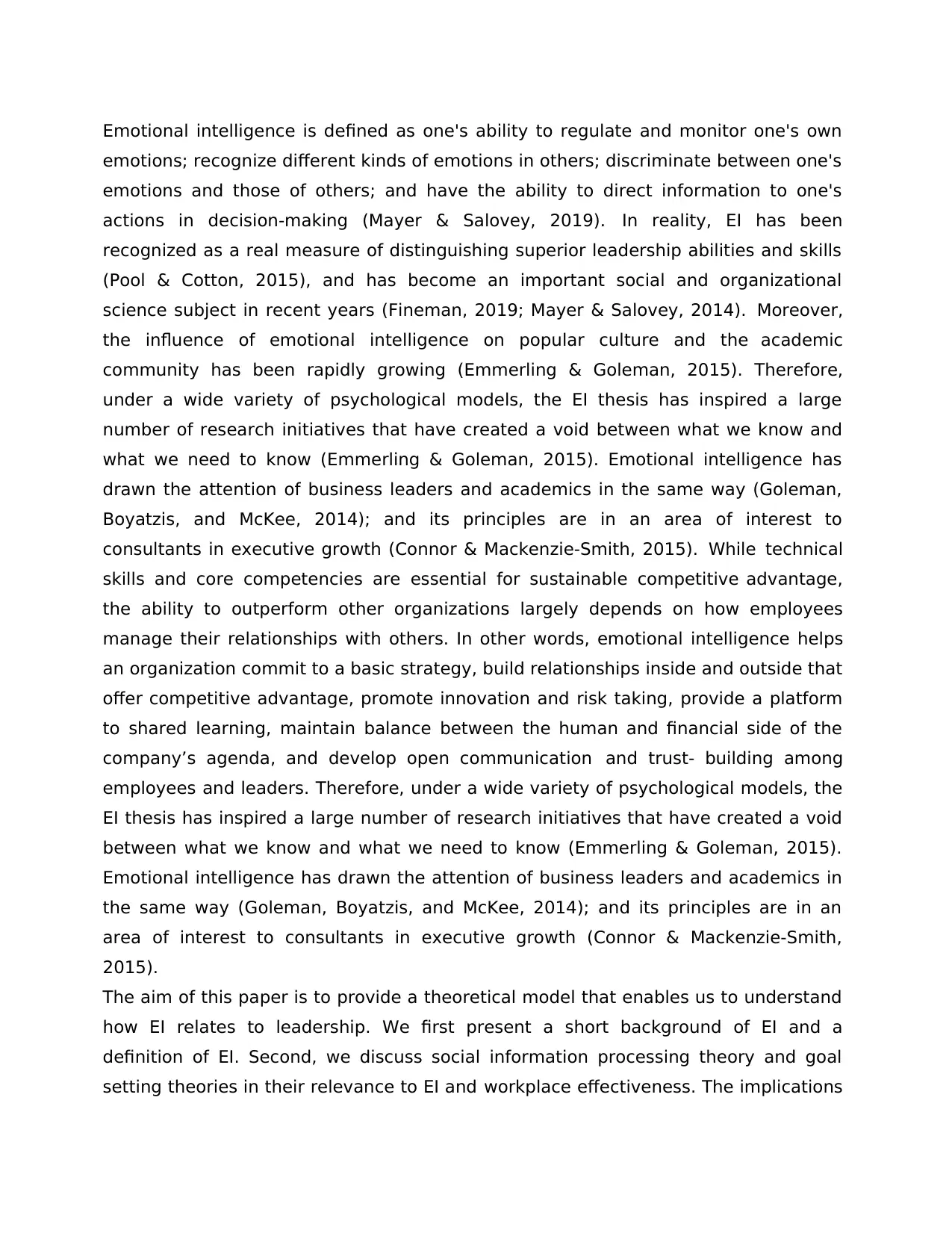
Emotional intelligence is defined as one's ability to regulate and monitor one's own
emotions; recognize different kinds of emotions in others; discriminate between one's
emotions and those of others; and have the ability to direct information to one's
actions in decision-making (Mayer & Salovey, 2019). In reality, EI has been
recognized as a real measure of distinguishing superior leadership abilities and skills
(Pool & Cotton, 2015), and has become an important social and organizational
science subject in recent years (Fineman, 2019; Mayer & Salovey, 2014). Moreover,
the influence of emotional intelligence on popular culture and the academic
community has been rapidly growing (Emmerling & Goleman, 2015). Therefore,
under a wide variety of psychological models, the EI thesis has inspired a large
number of research initiatives that have created a void between what we know and
what we need to know (Emmerling & Goleman, 2015). Emotional intelligence has
drawn the attention of business leaders and academics in the same way (Goleman,
Boyatzis, and McKee, 2014); and its principles are in an area of interest to
consultants in executive growth (Connor & Mackenzie-Smith, 2015). While technical
skills and core competencies are essential for sustainable competitive advantage,
the ability to outperform other organizations largely depends on how employees
manage their relationships with others. In other words, emotional intelligence helps
an organization commit to a basic strategy, build relationships inside and outside that
offer competitive advantage, promote innovation and risk taking, provide a platform
to shared learning, maintain balance between the human and financial side of the
company’s agenda, and develop open communication and trust- building among
employees and leaders. Therefore, under a wide variety of psychological models, the
EI thesis has inspired a large number of research initiatives that have created a void
between what we know and what we need to know (Emmerling & Goleman, 2015).
Emotional intelligence has drawn the attention of business leaders and academics in
the same way (Goleman, Boyatzis, and McKee, 2014); and its principles are in an
area of interest to consultants in executive growth (Connor & Mackenzie-Smith,
2015).
The aim of this paper is to provide a theoretical model that enables us to understand
how EI relates to leadership. We first present a short background of EI and a
definition of EI. Second, we discuss social information processing theory and goal
setting theories in their relevance to EI and workplace effectiveness. The implications
emotions; recognize different kinds of emotions in others; discriminate between one's
emotions and those of others; and have the ability to direct information to one's
actions in decision-making (Mayer & Salovey, 2019). In reality, EI has been
recognized as a real measure of distinguishing superior leadership abilities and skills
(Pool & Cotton, 2015), and has become an important social and organizational
science subject in recent years (Fineman, 2019; Mayer & Salovey, 2014). Moreover,
the influence of emotional intelligence on popular culture and the academic
community has been rapidly growing (Emmerling & Goleman, 2015). Therefore,
under a wide variety of psychological models, the EI thesis has inspired a large
number of research initiatives that have created a void between what we know and
what we need to know (Emmerling & Goleman, 2015). Emotional intelligence has
drawn the attention of business leaders and academics in the same way (Goleman,
Boyatzis, and McKee, 2014); and its principles are in an area of interest to
consultants in executive growth (Connor & Mackenzie-Smith, 2015). While technical
skills and core competencies are essential for sustainable competitive advantage,
the ability to outperform other organizations largely depends on how employees
manage their relationships with others. In other words, emotional intelligence helps
an organization commit to a basic strategy, build relationships inside and outside that
offer competitive advantage, promote innovation and risk taking, provide a platform
to shared learning, maintain balance between the human and financial side of the
company’s agenda, and develop open communication and trust- building among
employees and leaders. Therefore, under a wide variety of psychological models, the
EI thesis has inspired a large number of research initiatives that have created a void
between what we know and what we need to know (Emmerling & Goleman, 2015).
Emotional intelligence has drawn the attention of business leaders and academics in
the same way (Goleman, Boyatzis, and McKee, 2014); and its principles are in an
area of interest to consultants in executive growth (Connor & Mackenzie-Smith,
2015).
The aim of this paper is to provide a theoretical model that enables us to understand
how EI relates to leadership. We first present a short background of EI and a
definition of EI. Second, we discuss social information processing theory and goal
setting theories in their relevance to EI and workplace effectiveness. The implications
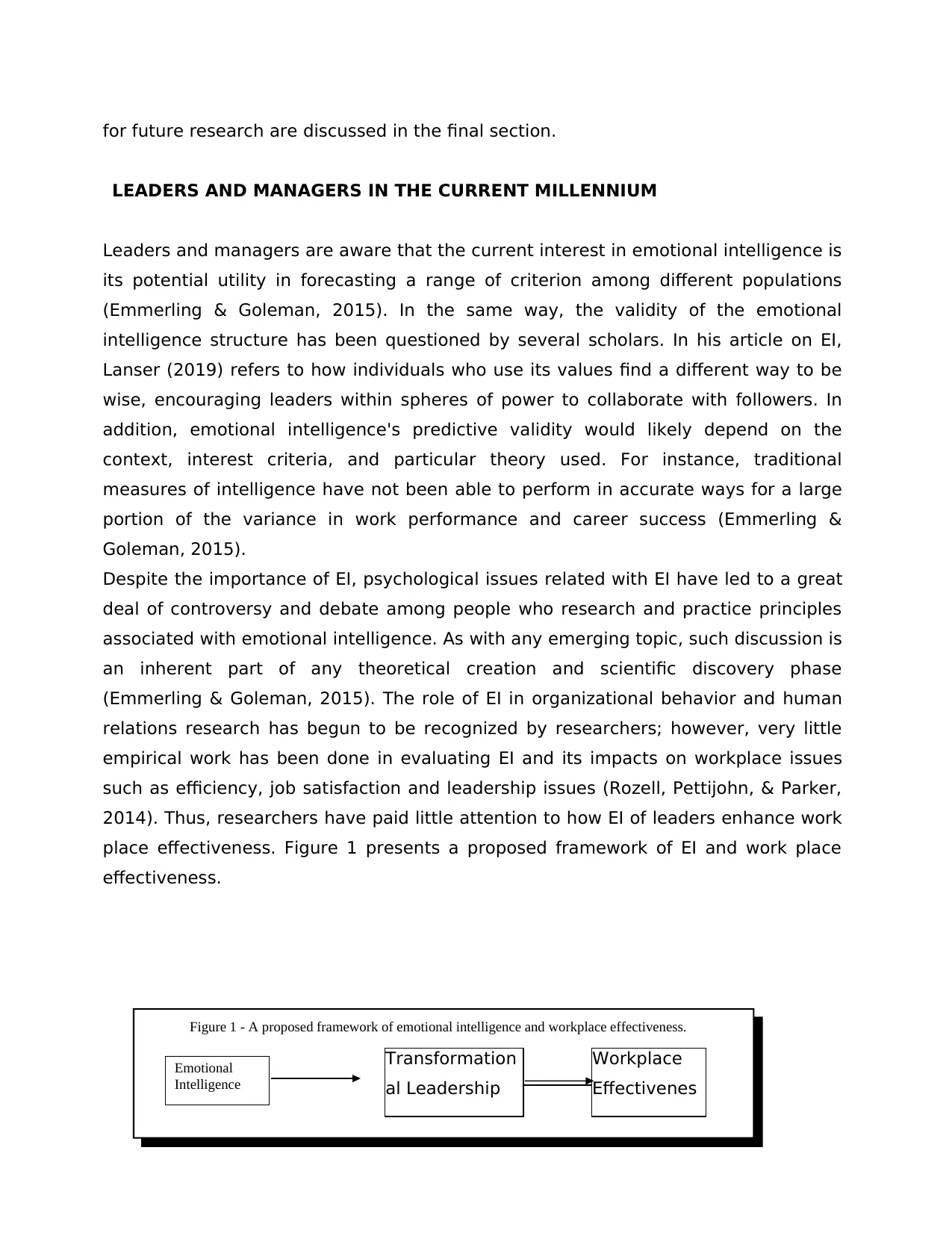
for future research are discussed in the final section.
LEADERS AND MANAGERS IN THE CURRENT MILLENNIUM
Leaders and managers are aware that the current interest in emotional intelligence is
its potential utility in forecasting a range of criterion among different populations
(Emmerling & Goleman, 2015). In the same way, the validity of the emotional
intelligence structure has been questioned by several scholars. In his article on EI,
Lanser (2019) refers to how individuals who use its values find a different way to be
wise, encouraging leaders within spheres of power to collaborate with followers. In
addition, emotional intelligence's predictive validity would likely depend on the
context, interest criteria, and particular theory used. For instance, traditional
measures of intelligence have not been able to perform in accurate ways for a large
portion of the variance in work performance and career success (Emmerling &
Goleman, 2015).
Despite the importance of EI, psychological issues related with EI have led to a great
deal of controversy and debate among people who research and practice principles
associated with emotional intelligence. As with any emerging topic, such discussion is
an inherent part of any theoretical creation and scientific discovery phase
(Emmerling & Goleman, 2015). The role of EI in organizational behavior and human
relations research has begun to be recognized by researchers; however, very little
empirical work has been done in evaluating EI and its impacts on workplace issues
such as efficiency, job satisfaction and leadership issues (Rozell, Pettijohn, & Parker,
2014). Thus, researchers have paid little attention to how EI of leaders enhance work
place effectiveness. Figure 1 presents a proposed framework of EI and work place
effectiveness.
Transformation
al Leadership
Workplace
Effectivenes
Emotional
Intelligence
Figure 1 - A proposed framework of emotional intelligence and workplace effectiveness.
LEADERS AND MANAGERS IN THE CURRENT MILLENNIUM
Leaders and managers are aware that the current interest in emotional intelligence is
its potential utility in forecasting a range of criterion among different populations
(Emmerling & Goleman, 2015). In the same way, the validity of the emotional
intelligence structure has been questioned by several scholars. In his article on EI,
Lanser (2019) refers to how individuals who use its values find a different way to be
wise, encouraging leaders within spheres of power to collaborate with followers. In
addition, emotional intelligence's predictive validity would likely depend on the
context, interest criteria, and particular theory used. For instance, traditional
measures of intelligence have not been able to perform in accurate ways for a large
portion of the variance in work performance and career success (Emmerling &
Goleman, 2015).
Despite the importance of EI, psychological issues related with EI have led to a great
deal of controversy and debate among people who research and practice principles
associated with emotional intelligence. As with any emerging topic, such discussion is
an inherent part of any theoretical creation and scientific discovery phase
(Emmerling & Goleman, 2015). The role of EI in organizational behavior and human
relations research has begun to be recognized by researchers; however, very little
empirical work has been done in evaluating EI and its impacts on workplace issues
such as efficiency, job satisfaction and leadership issues (Rozell, Pettijohn, & Parker,
2014). Thus, researchers have paid little attention to how EI of leaders enhance work
place effectiveness. Figure 1 presents a proposed framework of EI and work place
effectiveness.
Transformation
al Leadership
Workplace
Effectivenes
Emotional
Intelligence
Figure 1 - A proposed framework of emotional intelligence and workplace effectiveness.
Secure Best Marks with AI Grader
Need help grading? Try our AI Grader for instant feedback on your assignments.

s
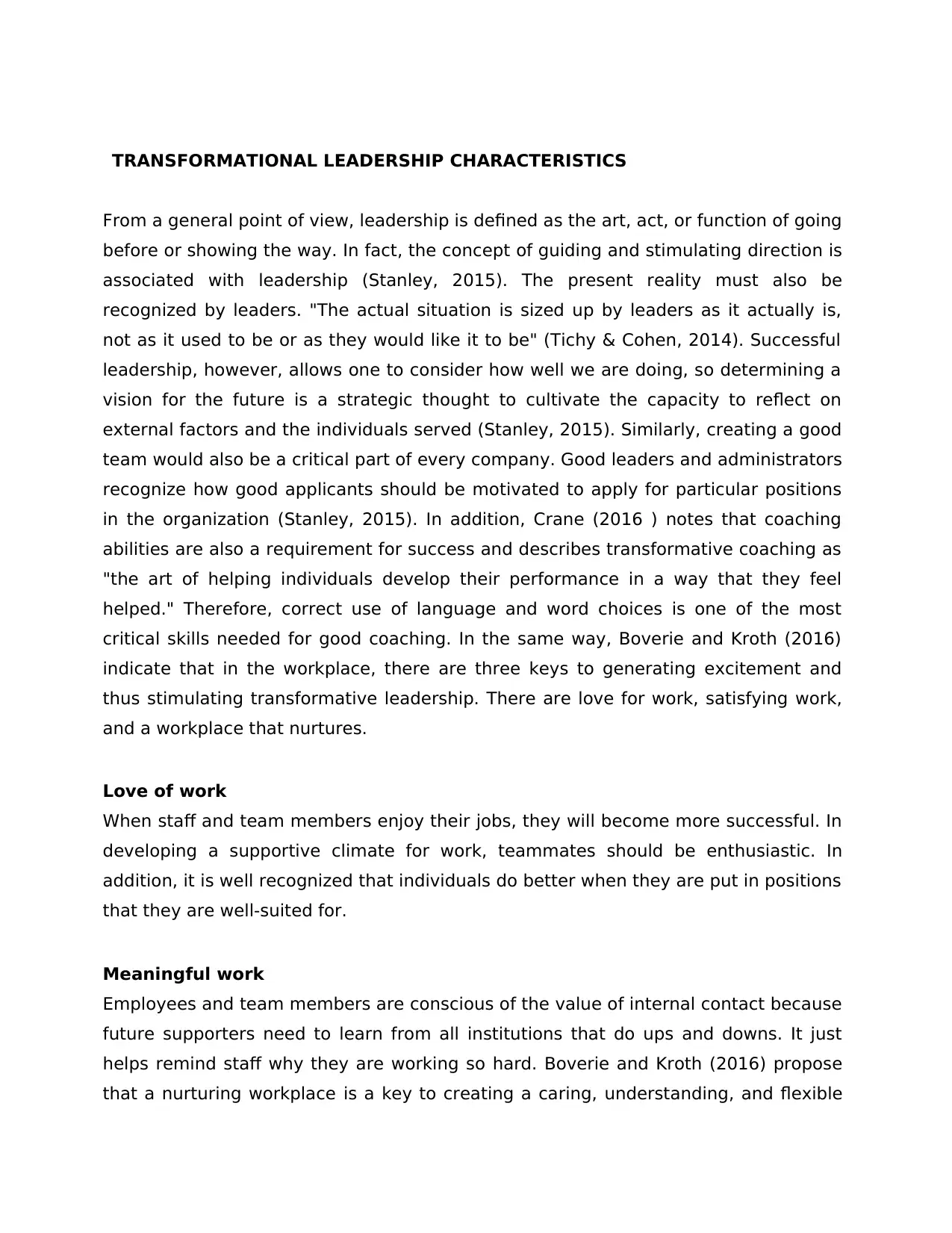
TRANSFORMATIONAL LEADERSHIP CHARACTERISTICS
From a general point of view, leadership is defined as the art, act, or function of going
before or showing the way. In fact, the concept of guiding and stimulating direction is
associated with leadership (Stanley, 2015). The present reality must also be
recognized by leaders. "The actual situation is sized up by leaders as it actually is,
not as it used to be or as they would like it to be" (Tichy & Cohen, 2014). Successful
leadership, however, allows one to consider how well we are doing, so determining a
vision for the future is a strategic thought to cultivate the capacity to reflect on
external factors and the individuals served (Stanley, 2015). Similarly, creating a good
team would also be a critical part of every company. Good leaders and administrators
recognize how good applicants should be motivated to apply for particular positions
in the organization (Stanley, 2015). In addition, Crane (2016 ) notes that coaching
abilities are also a requirement for success and describes transformative coaching as
"the art of helping individuals develop their performance in a way that they feel
helped." Therefore, correct use of language and word choices is one of the most
critical skills needed for good coaching. In the same way, Boverie and Kroth (2016)
indicate that in the workplace, there are three keys to generating excitement and
thus stimulating transformative leadership. There are love for work, satisfying work,
and a workplace that nurtures.
Love of work
When staff and team members enjoy their jobs, they will become more successful. In
developing a supportive climate for work, teammates should be enthusiastic. In
addition, it is well recognized that individuals do better when they are put in positions
that they are well-suited for.
Meaningful work
Employees and team members are conscious of the value of internal contact because
future supporters need to learn from all institutions that do ups and downs. It just
helps remind staff why they are working so hard. Boverie and Kroth (2016) propose
that a nurturing workplace is a key to creating a caring, understanding, and flexible
From a general point of view, leadership is defined as the art, act, or function of going
before or showing the way. In fact, the concept of guiding and stimulating direction is
associated with leadership (Stanley, 2015). The present reality must also be
recognized by leaders. "The actual situation is sized up by leaders as it actually is,
not as it used to be or as they would like it to be" (Tichy & Cohen, 2014). Successful
leadership, however, allows one to consider how well we are doing, so determining a
vision for the future is a strategic thought to cultivate the capacity to reflect on
external factors and the individuals served (Stanley, 2015). Similarly, creating a good
team would also be a critical part of every company. Good leaders and administrators
recognize how good applicants should be motivated to apply for particular positions
in the organization (Stanley, 2015). In addition, Crane (2016 ) notes that coaching
abilities are also a requirement for success and describes transformative coaching as
"the art of helping individuals develop their performance in a way that they feel
helped." Therefore, correct use of language and word choices is one of the most
critical skills needed for good coaching. In the same way, Boverie and Kroth (2016)
indicate that in the workplace, there are three keys to generating excitement and
thus stimulating transformative leadership. There are love for work, satisfying work,
and a workplace that nurtures.
Love of work
When staff and team members enjoy their jobs, they will become more successful. In
developing a supportive climate for work, teammates should be enthusiastic. In
addition, it is well recognized that individuals do better when they are put in positions
that they are well-suited for.
Meaningful work
Employees and team members are conscious of the value of internal contact because
future supporters need to learn from all institutions that do ups and downs. It just
helps remind staff why they are working so hard. Boverie and Kroth (2016) propose
that a nurturing workplace is a key to creating a caring, understanding, and flexible
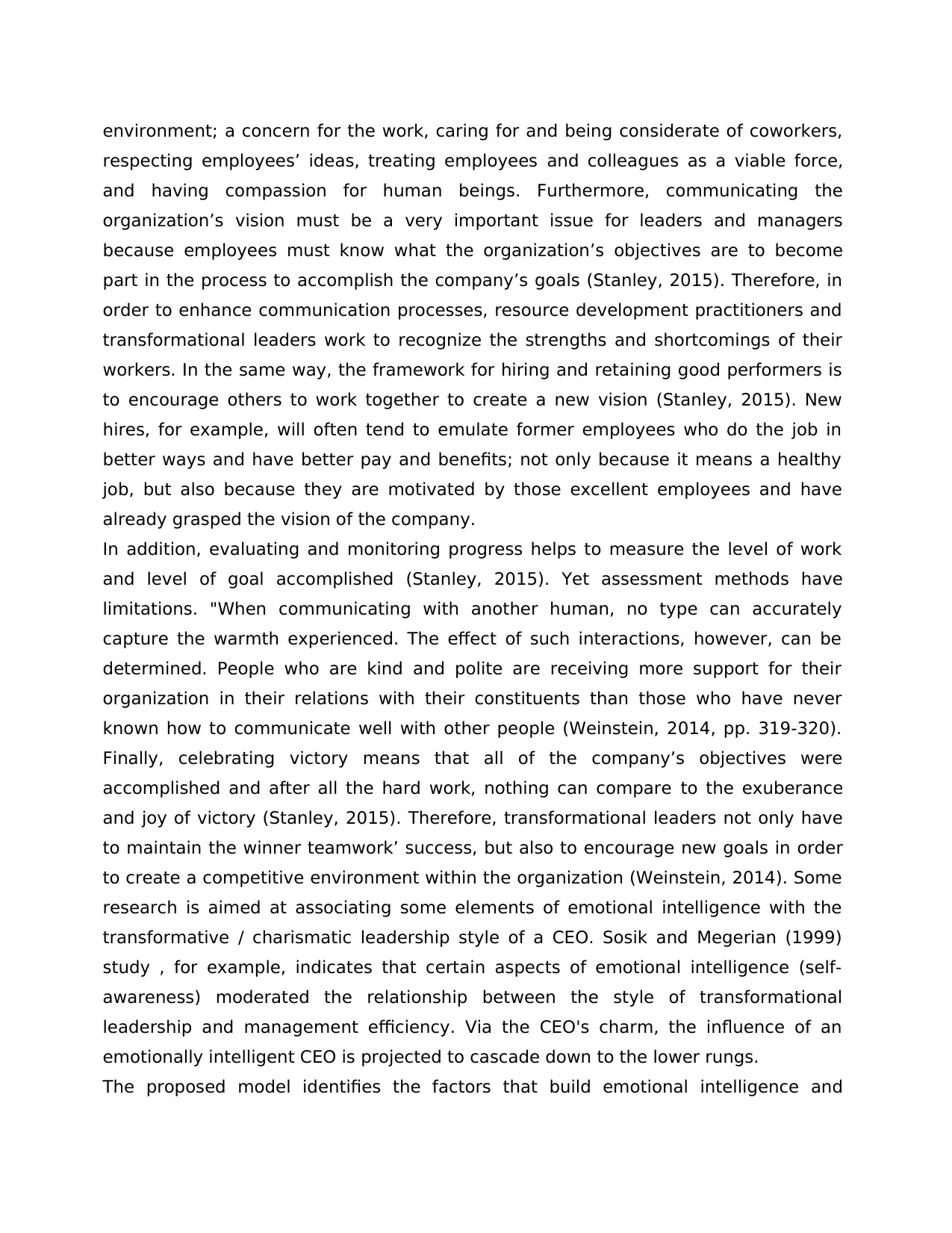
environment; a concern for the work, caring for and being considerate of coworkers,
respecting employees’ ideas, treating employees and colleagues as a viable force,
and having compassion for human beings. Furthermore, communicating the
organization’s vision must be a very important issue for leaders and managers
because employees must know what the organization’s objectives are to become
part in the process to accomplish the company’s goals (Stanley, 2015). Therefore, in
order to enhance communication processes, resource development practitioners and
transformational leaders work to recognize the strengths and shortcomings of their
workers. In the same way, the framework for hiring and retaining good performers is
to encourage others to work together to create a new vision (Stanley, 2015). New
hires, for example, will often tend to emulate former employees who do the job in
better ways and have better pay and benefits; not only because it means a healthy
job, but also because they are motivated by those excellent employees and have
already grasped the vision of the company.
In addition, evaluating and monitoring progress helps to measure the level of work
and level of goal accomplished (Stanley, 2015). Yet assessment methods have
limitations. "When communicating with another human, no type can accurately
capture the warmth experienced. The effect of such interactions, however, can be
determined. People who are kind and polite are receiving more support for their
organization in their relations with their constituents than those who have never
known how to communicate well with other people (Weinstein, 2014, pp. 319-320).
Finally, celebrating victory means that all of the company’s objectives were
accomplished and after all the hard work, nothing can compare to the exuberance
and joy of victory (Stanley, 2015). Therefore, transformational leaders not only have
to maintain the winner teamwork’ success, but also to encourage new goals in order
to create a competitive environment within the organization (Weinstein, 2014). Some
research is aimed at associating some elements of emotional intelligence with the
transformative / charismatic leadership style of a CEO. Sosik and Megerian (1999)
study , for example, indicates that certain aspects of emotional intelligence (self-
awareness) moderated the relationship between the style of transformational
leadership and management efficiency. Via the CEO's charm, the influence of an
emotionally intelligent CEO is projected to cascade down to the lower rungs.
The proposed model identifies the factors that build emotional intelligence and
respecting employees’ ideas, treating employees and colleagues as a viable force,
and having compassion for human beings. Furthermore, communicating the
organization’s vision must be a very important issue for leaders and managers
because employees must know what the organization’s objectives are to become
part in the process to accomplish the company’s goals (Stanley, 2015). Therefore, in
order to enhance communication processes, resource development practitioners and
transformational leaders work to recognize the strengths and shortcomings of their
workers. In the same way, the framework for hiring and retaining good performers is
to encourage others to work together to create a new vision (Stanley, 2015). New
hires, for example, will often tend to emulate former employees who do the job in
better ways and have better pay and benefits; not only because it means a healthy
job, but also because they are motivated by those excellent employees and have
already grasped the vision of the company.
In addition, evaluating and monitoring progress helps to measure the level of work
and level of goal accomplished (Stanley, 2015). Yet assessment methods have
limitations. "When communicating with another human, no type can accurately
capture the warmth experienced. The effect of such interactions, however, can be
determined. People who are kind and polite are receiving more support for their
organization in their relations with their constituents than those who have never
known how to communicate well with other people (Weinstein, 2014, pp. 319-320).
Finally, celebrating victory means that all of the company’s objectives were
accomplished and after all the hard work, nothing can compare to the exuberance
and joy of victory (Stanley, 2015). Therefore, transformational leaders not only have
to maintain the winner teamwork’ success, but also to encourage new goals in order
to create a competitive environment within the organization (Weinstein, 2014). Some
research is aimed at associating some elements of emotional intelligence with the
transformative / charismatic leadership style of a CEO. Sosik and Megerian (1999)
study , for example, indicates that certain aspects of emotional intelligence (self-
awareness) moderated the relationship between the style of transformational
leadership and management efficiency. Via the CEO's charm, the influence of an
emotionally intelligent CEO is projected to cascade down to the lower rungs.
The proposed model identifies the factors that build emotional intelligence and
Paraphrase This Document
Need a fresh take? Get an instant paraphrase of this document with our AI Paraphraser

highlights the ways that transformational leadership behaviors promote organizations
to become more open to change and to be more emotionally intelligent.
TRANSFORMATIONAL LEADERSHIP AND EMOTIONAL INTELLIGENCE
Transformational leaders have been described as individuals who increase interest
among followers to generate increased confidence, creating an adequate
environment in order to accomplish goals (Gardner & Stough, 2014). In fact,
transformational leaders are constantly searching for new possibilities because
among their followers, productivity must be a popular language. The following
dimensions are comprised of transformational leadership: idealized influence,
motivating inspiration, intellectual stimulation, and individualized consideration
(Bass, 2017). In addition, these leaders are able to demonstrate listening skills to
consider the requirements of people relevant to the work environment and to provide
all parties with real solutions (Rosen & Digh, 2016). In addition, Barling et al (2019)
conducted research with 49 managers to assess the relationship between leaders
who were high in emotional intelligence and likely to use transformative behaviors. In
conclusion, researchers discovered that transformational leaders were specifically
connected to the needs of followers, thereby becoming better able to perceive
personal problems. In the same manner, Gardner and Stough (2014) evaluated 110
senior level managers using the Swinburne University Emotional Intelligence Test
(SUEIT). A close association between EI and the style of transformational leadership
was confirmed by the findings. On the other hand, since these leaders were found to
be less able to consider their own personalities and those of those who operate in the
same position, a negative relationship was found between EI and both laissez-faire
leaders and transactional leaders (Gardner & Stough, 2014).
to become more open to change and to be more emotionally intelligent.
TRANSFORMATIONAL LEADERSHIP AND EMOTIONAL INTELLIGENCE
Transformational leaders have been described as individuals who increase interest
among followers to generate increased confidence, creating an adequate
environment in order to accomplish goals (Gardner & Stough, 2014). In fact,
transformational leaders are constantly searching for new possibilities because
among their followers, productivity must be a popular language. The following
dimensions are comprised of transformational leadership: idealized influence,
motivating inspiration, intellectual stimulation, and individualized consideration
(Bass, 2017). In addition, these leaders are able to demonstrate listening skills to
consider the requirements of people relevant to the work environment and to provide
all parties with real solutions (Rosen & Digh, 2016). In addition, Barling et al (2019)
conducted research with 49 managers to assess the relationship between leaders
who were high in emotional intelligence and likely to use transformative behaviors. In
conclusion, researchers discovered that transformational leaders were specifically
connected to the needs of followers, thereby becoming better able to perceive
personal problems. In the same manner, Gardner and Stough (2014) evaluated 110
senior level managers using the Swinburne University Emotional Intelligence Test
(SUEIT). A close association between EI and the style of transformational leadership
was confirmed by the findings. On the other hand, since these leaders were found to
be less able to consider their own personalities and those of those who operate in the
same position, a negative relationship was found between EI and both laissez-faire
leaders and transactional leaders (Gardner & Stough, 2014).
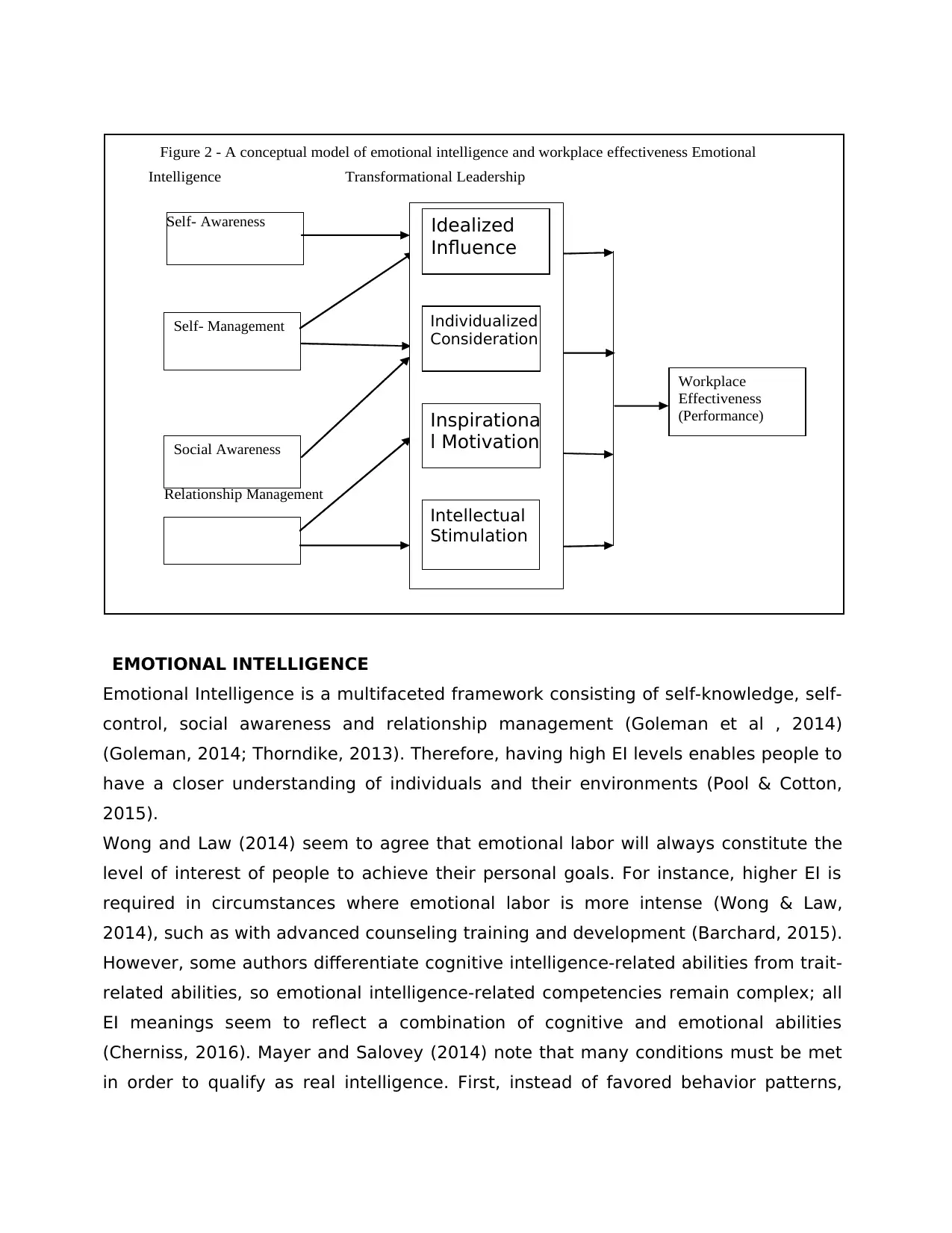
EMOTIONAL INTELLIGENCE
Emotional Intelligence is a multifaceted framework consisting of self-knowledge, self-
control, social awareness and relationship management (Goleman et al , 2014)
(Goleman, 2014; Thorndike, 2013). Therefore, having high EI levels enables people to
have a closer understanding of individuals and their environments (Pool & Cotton,
2015).
Wong and Law (2014) seem to agree that emotional labor will always constitute the
level of interest of people to achieve their personal goals. For instance, higher EI is
required in circumstances where emotional labor is more intense (Wong & Law,
2014), such as with advanced counseling training and development (Barchard, 2015).
However, some authors differentiate cognitive intelligence-related abilities from trait-
related abilities, so emotional intelligence-related competencies remain complex; all
EI meanings seem to reflect a combination of cognitive and emotional abilities
(Cherniss, 2016). Mayer and Salovey (2014) note that many conditions must be met
in order to qualify as real intelligence. First, instead of favored behavior patterns,
Idealized
Influence
Individualized
Consideration
Inspirationa
l Motivation
Intellectual
Stimulation
Self- Management
Workplace
Effectiveness
(Performance)
Social Awareness
Figure 2 - A conceptual model of emotional intelligence and workplace effectiveness Emotional
Intelligence Transformational Leadership
Self- Awareness
Relationship Management
Emotional Intelligence is a multifaceted framework consisting of self-knowledge, self-
control, social awareness and relationship management (Goleman et al , 2014)
(Goleman, 2014; Thorndike, 2013). Therefore, having high EI levels enables people to
have a closer understanding of individuals and their environments (Pool & Cotton,
2015).
Wong and Law (2014) seem to agree that emotional labor will always constitute the
level of interest of people to achieve their personal goals. For instance, higher EI is
required in circumstances where emotional labor is more intense (Wong & Law,
2014), such as with advanced counseling training and development (Barchard, 2015).
However, some authors differentiate cognitive intelligence-related abilities from trait-
related abilities, so emotional intelligence-related competencies remain complex; all
EI meanings seem to reflect a combination of cognitive and emotional abilities
(Cherniss, 2016). Mayer and Salovey (2014) note that many conditions must be met
in order to qualify as real intelligence. First, instead of favored behavior patterns,
Idealized
Influence
Individualized
Consideration
Inspirationa
l Motivation
Intellectual
Stimulation
Self- Management
Workplace
Effectiveness
(Performance)
Social Awareness
Figure 2 - A conceptual model of emotional intelligence and workplace effectiveness Emotional
Intelligence Transformational Leadership
Self- Awareness
Relationship Management

self-esteem, or other particular characteristics, any intelligence must reflect actual
mental output. Second, a collection of related abilities capable of displaying a
different pattern of intelligence should be defined by the level of intelligence under
study; and third, intelligence should grow with age.
Self-Awareness
The ability to understand what one is feeling and how to guide those feelings is self-
awareness (Gardner & Stough, 2014). Self-awareness often means being mindful of
one's strengths and shortcomings under some situations, so self-awareness is a
crucial aspect of emotional intelligence and core competency (Goleman et al, 2014).
In reality, being aware of one's strengths and weaknesses provides a real backbone
for managing feelings in any region and being a better motivator (Pool & Cotton,
2015). In that it can have a profound effect on behavioral self-management and on
desirable performance, the self-awareness aspect of EI is significant. Three
components consist of self-knowledge: emotional knowledge, precise self-
assessment, and self-confidence. The capacity to understand one 's feelings and their
consequences is emotional self-awareness. People who are high in this system
understand what emotions they feel and why; understand the connections between
their feelings and what they think, do, and say; understand how their emotions
influence their performance; and have a knowledge of values and priorities that
directs them (Goleman, 2018). For a person to have knowledge of his or her own
strengths and weaknesses, accurate self-assessment is important. Openness to
candid input, fresh perspectives, continuous learning, and self-development are
needed for self-assessment. A sense of humor and insight about themselves is
demonstrated by people with a high degree of emotional self-awareness. Self-
awareness, which talks of self-worth and skills, often requires self-confidence.
Individuals with high faith in themselves may freely and unhesitatingly share their
thoughts, opinions, and points of view. Further, research has demonstrated that self-
confident people are more decisive, and are able to make sound decisions (Phillips &
Gully, 2014).
Self-awareness helps a leader to look at what might be the perfect scenario without
thinking about their egos and fantasies. In his or her own right, a leader with good
self-awareness feels satisfied and is not intimidated by other accomplishments.
Followers are permitted to take credit and reap the honors of achievement, even
mental output. Second, a collection of related abilities capable of displaying a
different pattern of intelligence should be defined by the level of intelligence under
study; and third, intelligence should grow with age.
Self-Awareness
The ability to understand what one is feeling and how to guide those feelings is self-
awareness (Gardner & Stough, 2014). Self-awareness often means being mindful of
one's strengths and shortcomings under some situations, so self-awareness is a
crucial aspect of emotional intelligence and core competency (Goleman et al, 2014).
In reality, being aware of one's strengths and weaknesses provides a real backbone
for managing feelings in any region and being a better motivator (Pool & Cotton,
2015). In that it can have a profound effect on behavioral self-management and on
desirable performance, the self-awareness aspect of EI is significant. Three
components consist of self-knowledge: emotional knowledge, precise self-
assessment, and self-confidence. The capacity to understand one 's feelings and their
consequences is emotional self-awareness. People who are high in this system
understand what emotions they feel and why; understand the connections between
their feelings and what they think, do, and say; understand how their emotions
influence their performance; and have a knowledge of values and priorities that
directs them (Goleman, 2018). For a person to have knowledge of his or her own
strengths and weaknesses, accurate self-assessment is important. Openness to
candid input, fresh perspectives, continuous learning, and self-development are
needed for self-assessment. A sense of humor and insight about themselves is
demonstrated by people with a high degree of emotional self-awareness. Self-
awareness, which talks of self-worth and skills, often requires self-confidence.
Individuals with high faith in themselves may freely and unhesitatingly share their
thoughts, opinions, and points of view. Further, research has demonstrated that self-
confident people are more decisive, and are able to make sound decisions (Phillips &
Gully, 2014).
Self-awareness helps a leader to look at what might be the perfect scenario without
thinking about their egos and fantasies. In his or her own right, a leader with good
self-awareness feels satisfied and is not intimidated by other accomplishments.
Followers are permitted to take credit and reap the honors of achievement, even
Secure Best Marks with AI Grader
Need help grading? Try our AI Grader for instant feedback on your assignments.
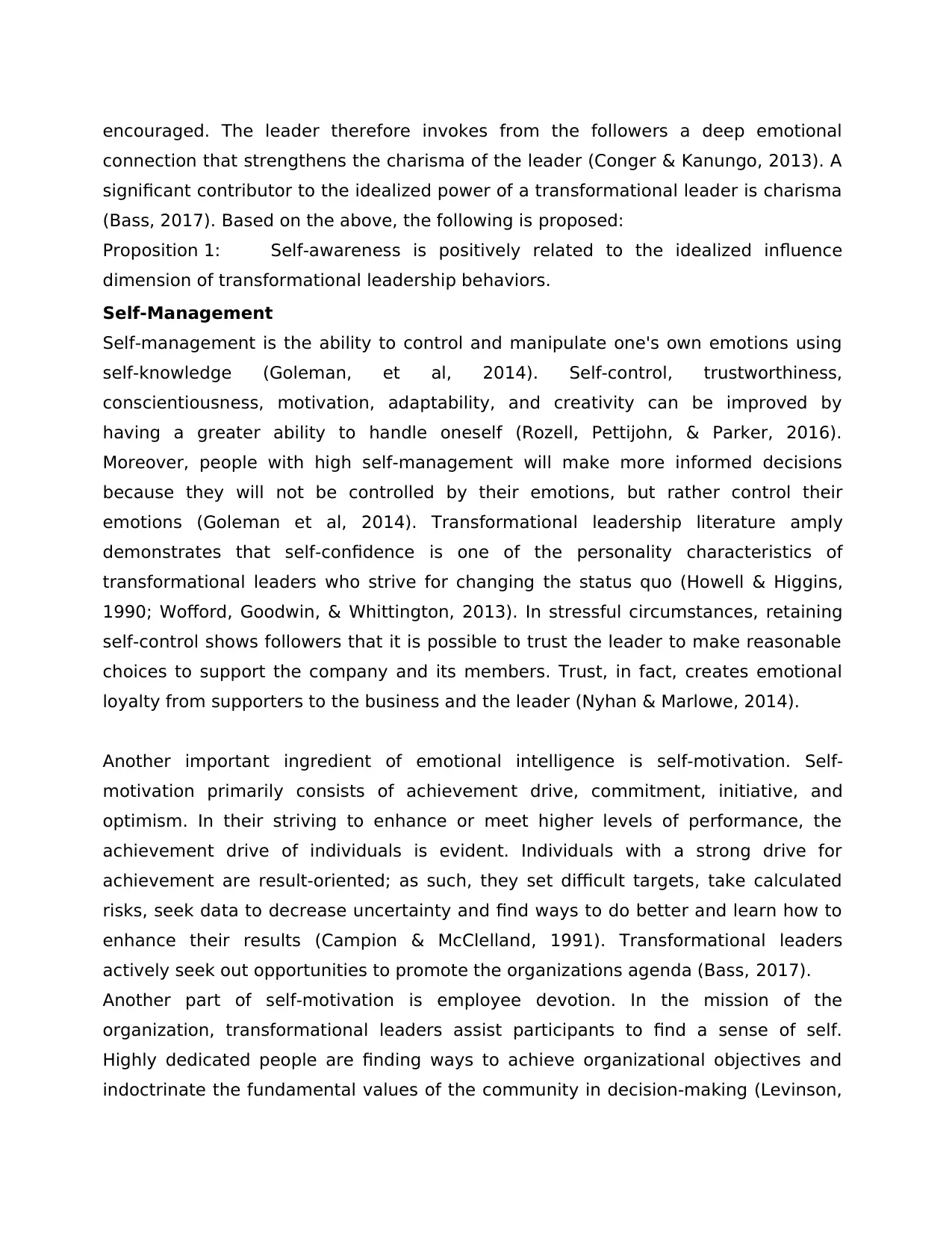
encouraged. The leader therefore invokes from the followers a deep emotional
connection that strengthens the charisma of the leader (Conger & Kanungo, 2013). A
significant contributor to the idealized power of a transformational leader is charisma
(Bass, 2017). Based on the above, the following is proposed:
Proposition 1: Self-awareness is positively related to the idealized influence
dimension of transformational leadership behaviors.
Self-Management
Self-management is the ability to control and manipulate one's own emotions using
self-knowledge (Goleman, et al, 2014). Self-control, trustworthiness,
conscientiousness, motivation, adaptability, and creativity can be improved by
having a greater ability to handle oneself (Rozell, Pettijohn, & Parker, 2016).
Moreover, people with high self-management will make more informed decisions
because they will not be controlled by their emotions, but rather control their
emotions (Goleman et al, 2014). Transformational leadership literature amply
demonstrates that self-confidence is one of the personality characteristics of
transformational leaders who strive for changing the status quo (Howell & Higgins,
1990; Wofford, Goodwin, & Whittington, 2013). In stressful circumstances, retaining
self-control shows followers that it is possible to trust the leader to make reasonable
choices to support the company and its members. Trust, in fact, creates emotional
loyalty from supporters to the business and the leader (Nyhan & Marlowe, 2014).
Another important ingredient of emotional intelligence is self-motivation. Self-
motivation primarily consists of achievement drive, commitment, initiative, and
optimism. In their striving to enhance or meet higher levels of performance, the
achievement drive of individuals is evident. Individuals with a strong drive for
achievement are result-oriented; as such, they set difficult targets, take calculated
risks, seek data to decrease uncertainty and find ways to do better and learn how to
enhance their results (Campion & McClelland, 1991). Transformational leaders
actively seek out opportunities to promote the organizations agenda (Bass, 2017).
Another part of self-motivation is employee devotion. In the mission of the
organization, transformational leaders assist participants to find a sense of self.
Highly dedicated people are finding ways to achieve organizational objectives and
indoctrinate the fundamental values of the community in decision-making (Levinson,
connection that strengthens the charisma of the leader (Conger & Kanungo, 2013). A
significant contributor to the idealized power of a transformational leader is charisma
(Bass, 2017). Based on the above, the following is proposed:
Proposition 1: Self-awareness is positively related to the idealized influence
dimension of transformational leadership behaviors.
Self-Management
Self-management is the ability to control and manipulate one's own emotions using
self-knowledge (Goleman, et al, 2014). Self-control, trustworthiness,
conscientiousness, motivation, adaptability, and creativity can be improved by
having a greater ability to handle oneself (Rozell, Pettijohn, & Parker, 2016).
Moreover, people with high self-management will make more informed decisions
because they will not be controlled by their emotions, but rather control their
emotions (Goleman et al, 2014). Transformational leadership literature amply
demonstrates that self-confidence is one of the personality characteristics of
transformational leaders who strive for changing the status quo (Howell & Higgins,
1990; Wofford, Goodwin, & Whittington, 2013). In stressful circumstances, retaining
self-control shows followers that it is possible to trust the leader to make reasonable
choices to support the company and its members. Trust, in fact, creates emotional
loyalty from supporters to the business and the leader (Nyhan & Marlowe, 2014).
Another important ingredient of emotional intelligence is self-motivation. Self-
motivation primarily consists of achievement drive, commitment, initiative, and
optimism. In their striving to enhance or meet higher levels of performance, the
achievement drive of individuals is evident. Individuals with a strong drive for
achievement are result-oriented; as such, they set difficult targets, take calculated
risks, seek data to decrease uncertainty and find ways to do better and learn how to
enhance their results (Campion & McClelland, 1991). Transformational leaders
actively seek out opportunities to promote the organizations agenda (Bass, 2017).
Another part of self-motivation is employee devotion. In the mission of the
organization, transformational leaders assist participants to find a sense of self.
Highly dedicated people are finding ways to achieve organizational objectives and
indoctrinate the fundamental values of the community in decision-making (Levinson,
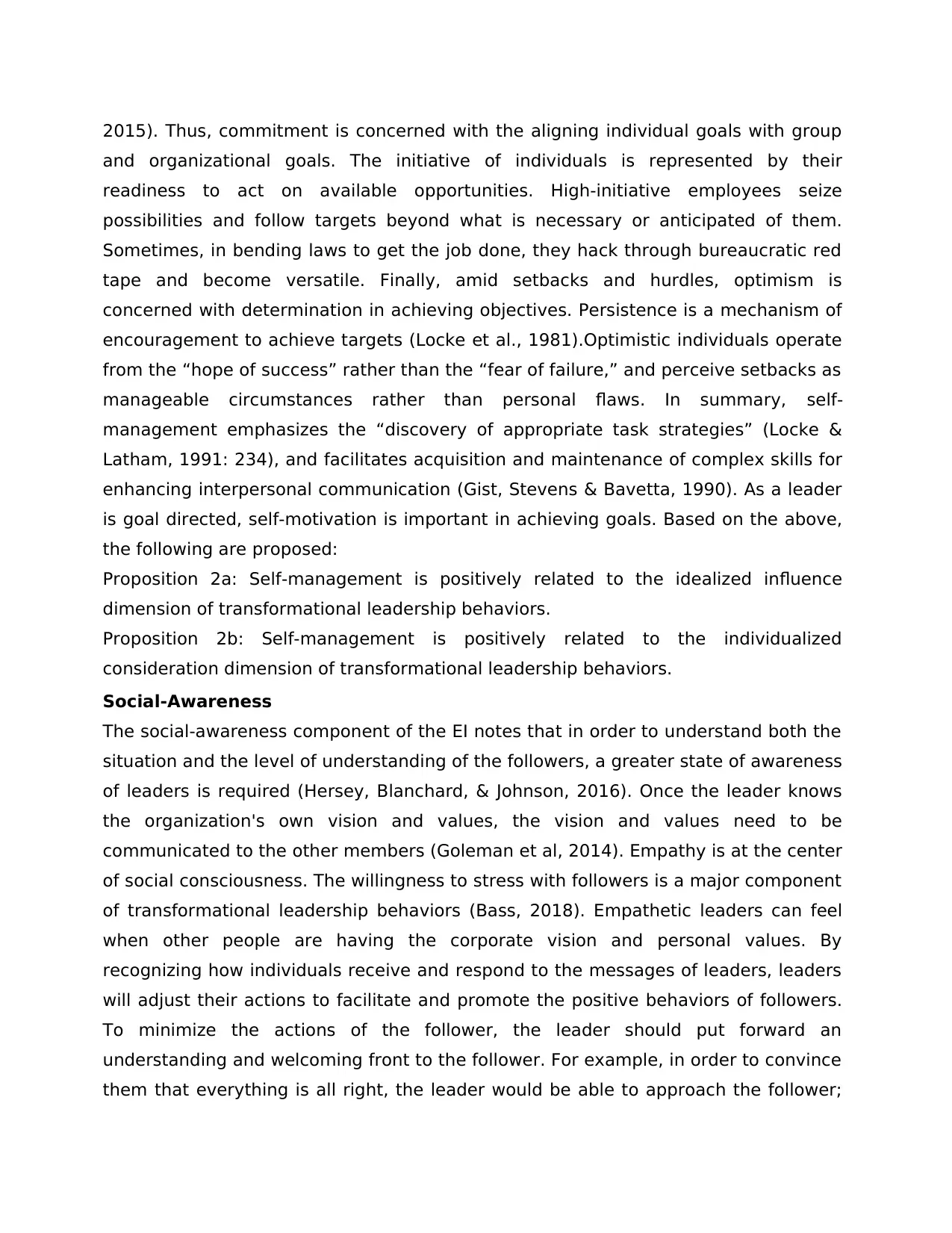
2015). Thus, commitment is concerned with the aligning individual goals with group
and organizational goals. The initiative of individuals is represented by their
readiness to act on available opportunities. High-initiative employees seize
possibilities and follow targets beyond what is necessary or anticipated of them.
Sometimes, in bending laws to get the job done, they hack through bureaucratic red
tape and become versatile. Finally, amid setbacks and hurdles, optimism is
concerned with determination in achieving objectives. Persistence is a mechanism of
encouragement to achieve targets (Locke et al., 1981).Optimistic individuals operate
from the “hope of success” rather than the “fear of failure,” and perceive setbacks as
manageable circumstances rather than personal flaws. In summary, self-
management emphasizes the “discovery of appropriate task strategies” (Locke &
Latham, 1991: 234), and facilitates acquisition and maintenance of complex skills for
enhancing interpersonal communication (Gist, Stevens & Bavetta, 1990). As a leader
is goal directed, self-motivation is important in achieving goals. Based on the above,
the following are proposed:
Proposition 2a: Self-management is positively related to the idealized influence
dimension of transformational leadership behaviors.
Proposition 2b: Self-management is positively related to the individualized
consideration dimension of transformational leadership behaviors.
Social-Awareness
The social-awareness component of the EI notes that in order to understand both the
situation and the level of understanding of the followers, a greater state of awareness
of leaders is required (Hersey, Blanchard, & Johnson, 2016). Once the leader knows
the organization's own vision and values, the vision and values need to be
communicated to the other members (Goleman et al, 2014). Empathy is at the center
of social consciousness. The willingness to stress with followers is a major component
of transformational leadership behaviors (Bass, 2018). Empathetic leaders can feel
when other people are having the corporate vision and personal values. By
recognizing how individuals receive and respond to the messages of leaders, leaders
will adjust their actions to facilitate and promote the positive behaviors of followers.
To minimize the actions of the follower, the leader should put forward an
understanding and welcoming front to the follower. For example, in order to convince
them that everything is all right, the leader would be able to approach the follower;
and organizational goals. The initiative of individuals is represented by their
readiness to act on available opportunities. High-initiative employees seize
possibilities and follow targets beyond what is necessary or anticipated of them.
Sometimes, in bending laws to get the job done, they hack through bureaucratic red
tape and become versatile. Finally, amid setbacks and hurdles, optimism is
concerned with determination in achieving objectives. Persistence is a mechanism of
encouragement to achieve targets (Locke et al., 1981).Optimistic individuals operate
from the “hope of success” rather than the “fear of failure,” and perceive setbacks as
manageable circumstances rather than personal flaws. In summary, self-
management emphasizes the “discovery of appropriate task strategies” (Locke &
Latham, 1991: 234), and facilitates acquisition and maintenance of complex skills for
enhancing interpersonal communication (Gist, Stevens & Bavetta, 1990). As a leader
is goal directed, self-motivation is important in achieving goals. Based on the above,
the following are proposed:
Proposition 2a: Self-management is positively related to the idealized influence
dimension of transformational leadership behaviors.
Proposition 2b: Self-management is positively related to the individualized
consideration dimension of transformational leadership behaviors.
Social-Awareness
The social-awareness component of the EI notes that in order to understand both the
situation and the level of understanding of the followers, a greater state of awareness
of leaders is required (Hersey, Blanchard, & Johnson, 2016). Once the leader knows
the organization's own vision and values, the vision and values need to be
communicated to the other members (Goleman et al, 2014). Empathy is at the center
of social consciousness. The willingness to stress with followers is a major component
of transformational leadership behaviors (Bass, 2018). Empathetic leaders can feel
when other people are having the corporate vision and personal values. By
recognizing how individuals receive and respond to the messages of leaders, leaders
will adjust their actions to facilitate and promote the positive behaviors of followers.
To minimize the actions of the follower, the leader should put forward an
understanding and welcoming front to the follower. For example, in order to convince
them that everything is all right, the leader would be able to approach the follower;
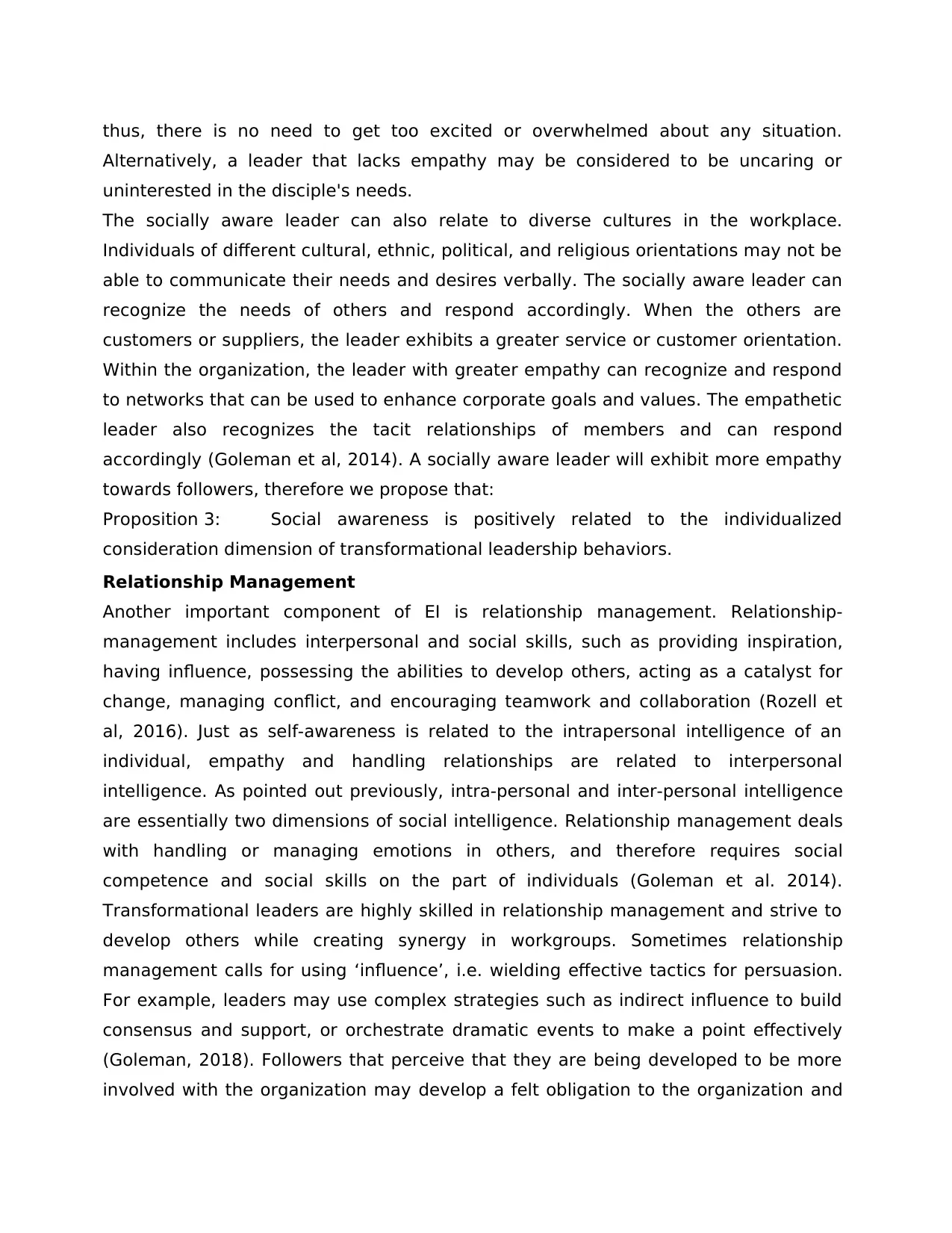
thus, there is no need to get too excited or overwhelmed about any situation.
Alternatively, a leader that lacks empathy may be considered to be uncaring or
uninterested in the disciple's needs.
The socially aware leader can also relate to diverse cultures in the workplace.
Individuals of different cultural, ethnic, political, and religious orientations may not be
able to communicate their needs and desires verbally. The socially aware leader can
recognize the needs of others and respond accordingly. When the others are
customers or suppliers, the leader exhibits a greater service or customer orientation.
Within the organization, the leader with greater empathy can recognize and respond
to networks that can be used to enhance corporate goals and values. The empathetic
leader also recognizes the tacit relationships of members and can respond
accordingly (Goleman et al, 2014). A socially aware leader will exhibit more empathy
towards followers, therefore we propose that:
Proposition 3: Social awareness is positively related to the individualized
consideration dimension of transformational leadership behaviors.
Relationship Management
Another important component of EI is relationship management. Relationship-
management includes interpersonal and social skills, such as providing inspiration,
having influence, possessing the abilities to develop others, acting as a catalyst for
change, managing conflict, and encouraging teamwork and collaboration (Rozell et
al, 2016). Just as self-awareness is related to the intrapersonal intelligence of an
individual, empathy and handling relationships are related to interpersonal
intelligence. As pointed out previously, intra-personal and inter-personal intelligence
are essentially two dimensions of social intelligence. Relationship management deals
with handling or managing emotions in others, and therefore requires social
competence and social skills on the part of individuals (Goleman et al. 2014).
Transformational leaders are highly skilled in relationship management and strive to
develop others while creating synergy in workgroups. Sometimes relationship
management calls for using ‘influence’, i.e. wielding effective tactics for persuasion.
For example, leaders may use complex strategies such as indirect influence to build
consensus and support, or orchestrate dramatic events to make a point effectively
(Goleman, 2018). Followers that perceive that they are being developed to be more
involved with the organization may develop a felt obligation to the organization and
Alternatively, a leader that lacks empathy may be considered to be uncaring or
uninterested in the disciple's needs.
The socially aware leader can also relate to diverse cultures in the workplace.
Individuals of different cultural, ethnic, political, and religious orientations may not be
able to communicate their needs and desires verbally. The socially aware leader can
recognize the needs of others and respond accordingly. When the others are
customers or suppliers, the leader exhibits a greater service or customer orientation.
Within the organization, the leader with greater empathy can recognize and respond
to networks that can be used to enhance corporate goals and values. The empathetic
leader also recognizes the tacit relationships of members and can respond
accordingly (Goleman et al, 2014). A socially aware leader will exhibit more empathy
towards followers, therefore we propose that:
Proposition 3: Social awareness is positively related to the individualized
consideration dimension of transformational leadership behaviors.
Relationship Management
Another important component of EI is relationship management. Relationship-
management includes interpersonal and social skills, such as providing inspiration,
having influence, possessing the abilities to develop others, acting as a catalyst for
change, managing conflict, and encouraging teamwork and collaboration (Rozell et
al, 2016). Just as self-awareness is related to the intrapersonal intelligence of an
individual, empathy and handling relationships are related to interpersonal
intelligence. As pointed out previously, intra-personal and inter-personal intelligence
are essentially two dimensions of social intelligence. Relationship management deals
with handling or managing emotions in others, and therefore requires social
competence and social skills on the part of individuals (Goleman et al. 2014).
Transformational leaders are highly skilled in relationship management and strive to
develop others while creating synergy in workgroups. Sometimes relationship
management calls for using ‘influence’, i.e. wielding effective tactics for persuasion.
For example, leaders may use complex strategies such as indirect influence to build
consensus and support, or orchestrate dramatic events to make a point effectively
(Goleman, 2018). Followers that perceive that they are being developed to be more
involved with the organization may develop a felt obligation to the organization and
Paraphrase This Document
Need a fresh take? Get an instant paraphrase of this document with our AI Paraphraser
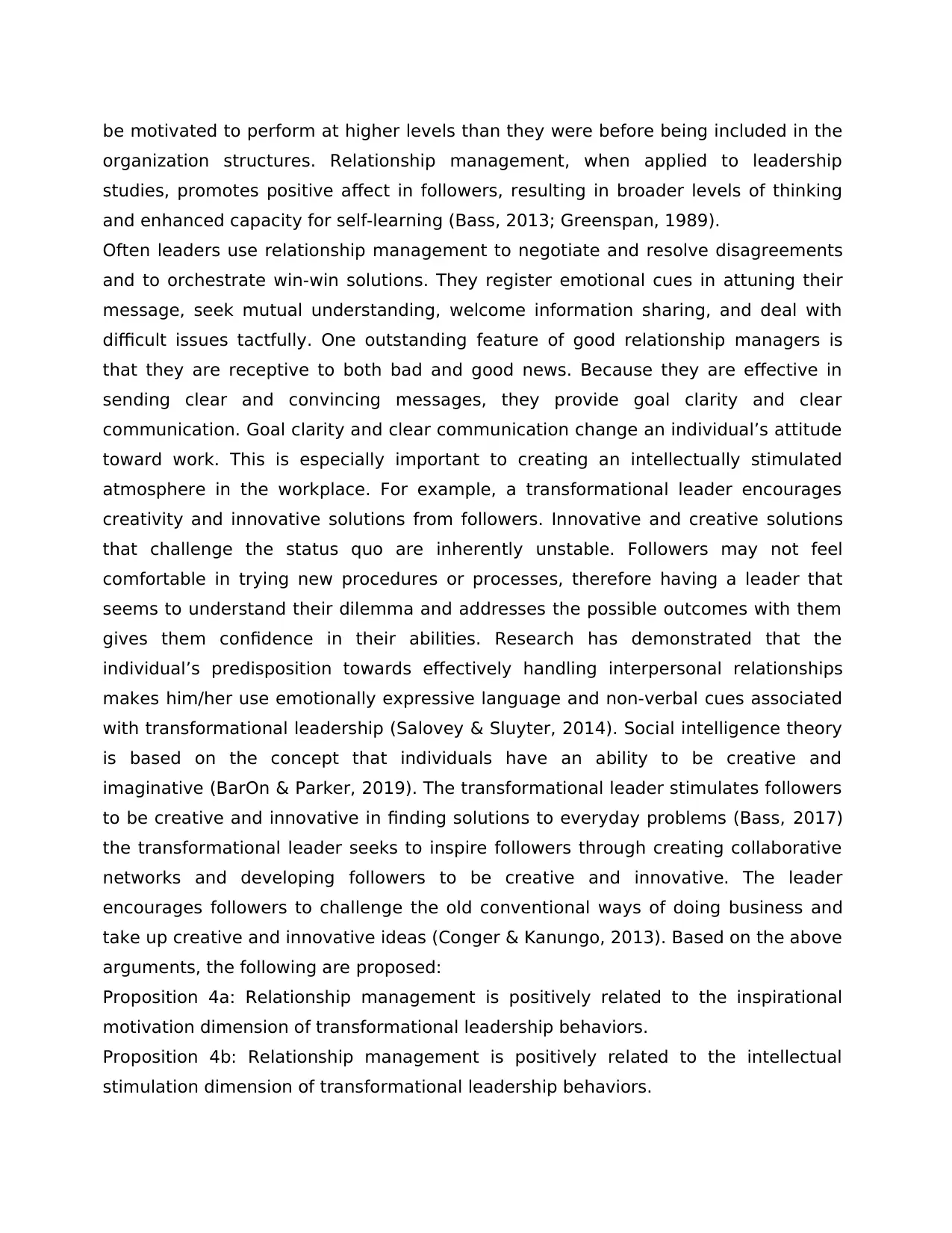
be motivated to perform at higher levels than they were before being included in the
organization structures. Relationship management, when applied to leadership
studies, promotes positive affect in followers, resulting in broader levels of thinking
and enhanced capacity for self-learning (Bass, 2013; Greenspan, 1989).
Often leaders use relationship management to negotiate and resolve disagreements
and to orchestrate win-win solutions. They register emotional cues in attuning their
message, seek mutual understanding, welcome information sharing, and deal with
difficult issues tactfully. One outstanding feature of good relationship managers is
that they are receptive to both bad and good news. Because they are effective in
sending clear and convincing messages, they provide goal clarity and clear
communication. Goal clarity and clear communication change an individual’s attitude
toward work. This is especially important to creating an intellectually stimulated
atmosphere in the workplace. For example, a transformational leader encourages
creativity and innovative solutions from followers. Innovative and creative solutions
that challenge the status quo are inherently unstable. Followers may not feel
comfortable in trying new procedures or processes, therefore having a leader that
seems to understand their dilemma and addresses the possible outcomes with them
gives them confidence in their abilities. Research has demonstrated that the
individual’s predisposition towards effectively handling interpersonal relationships
makes him/her use emotionally expressive language and non-verbal cues associated
with transformational leadership (Salovey & Sluyter, 2014). Social intelligence theory
is based on the concept that individuals have an ability to be creative and
imaginative (BarOn & Parker, 2019). The transformational leader stimulates followers
to be creative and innovative in finding solutions to everyday problems (Bass, 2017)
the transformational leader seeks to inspire followers through creating collaborative
networks and developing followers to be creative and innovative. The leader
encourages followers to challenge the old conventional ways of doing business and
take up creative and innovative ideas (Conger & Kanungo, 2013). Based on the above
arguments, the following are proposed:
Proposition 4a: Relationship management is positively related to the inspirational
motivation dimension of transformational leadership behaviors.
Proposition 4b: Relationship management is positively related to the intellectual
stimulation dimension of transformational leadership behaviors.
organization structures. Relationship management, when applied to leadership
studies, promotes positive affect in followers, resulting in broader levels of thinking
and enhanced capacity for self-learning (Bass, 2013; Greenspan, 1989).
Often leaders use relationship management to negotiate and resolve disagreements
and to orchestrate win-win solutions. They register emotional cues in attuning their
message, seek mutual understanding, welcome information sharing, and deal with
difficult issues tactfully. One outstanding feature of good relationship managers is
that they are receptive to both bad and good news. Because they are effective in
sending clear and convincing messages, they provide goal clarity and clear
communication. Goal clarity and clear communication change an individual’s attitude
toward work. This is especially important to creating an intellectually stimulated
atmosphere in the workplace. For example, a transformational leader encourages
creativity and innovative solutions from followers. Innovative and creative solutions
that challenge the status quo are inherently unstable. Followers may not feel
comfortable in trying new procedures or processes, therefore having a leader that
seems to understand their dilemma and addresses the possible outcomes with them
gives them confidence in their abilities. Research has demonstrated that the
individual’s predisposition towards effectively handling interpersonal relationships
makes him/her use emotionally expressive language and non-verbal cues associated
with transformational leadership (Salovey & Sluyter, 2014). Social intelligence theory
is based on the concept that individuals have an ability to be creative and
imaginative (BarOn & Parker, 2019). The transformational leader stimulates followers
to be creative and innovative in finding solutions to everyday problems (Bass, 2017)
the transformational leader seeks to inspire followers through creating collaborative
networks and developing followers to be creative and innovative. The leader
encourages followers to challenge the old conventional ways of doing business and
take up creative and innovative ideas (Conger & Kanungo, 2013). Based on the above
arguments, the following are proposed:
Proposition 4a: Relationship management is positively related to the inspirational
motivation dimension of transformational leadership behaviors.
Proposition 4b: Relationship management is positively related to the intellectual
stimulation dimension of transformational leadership behaviors.
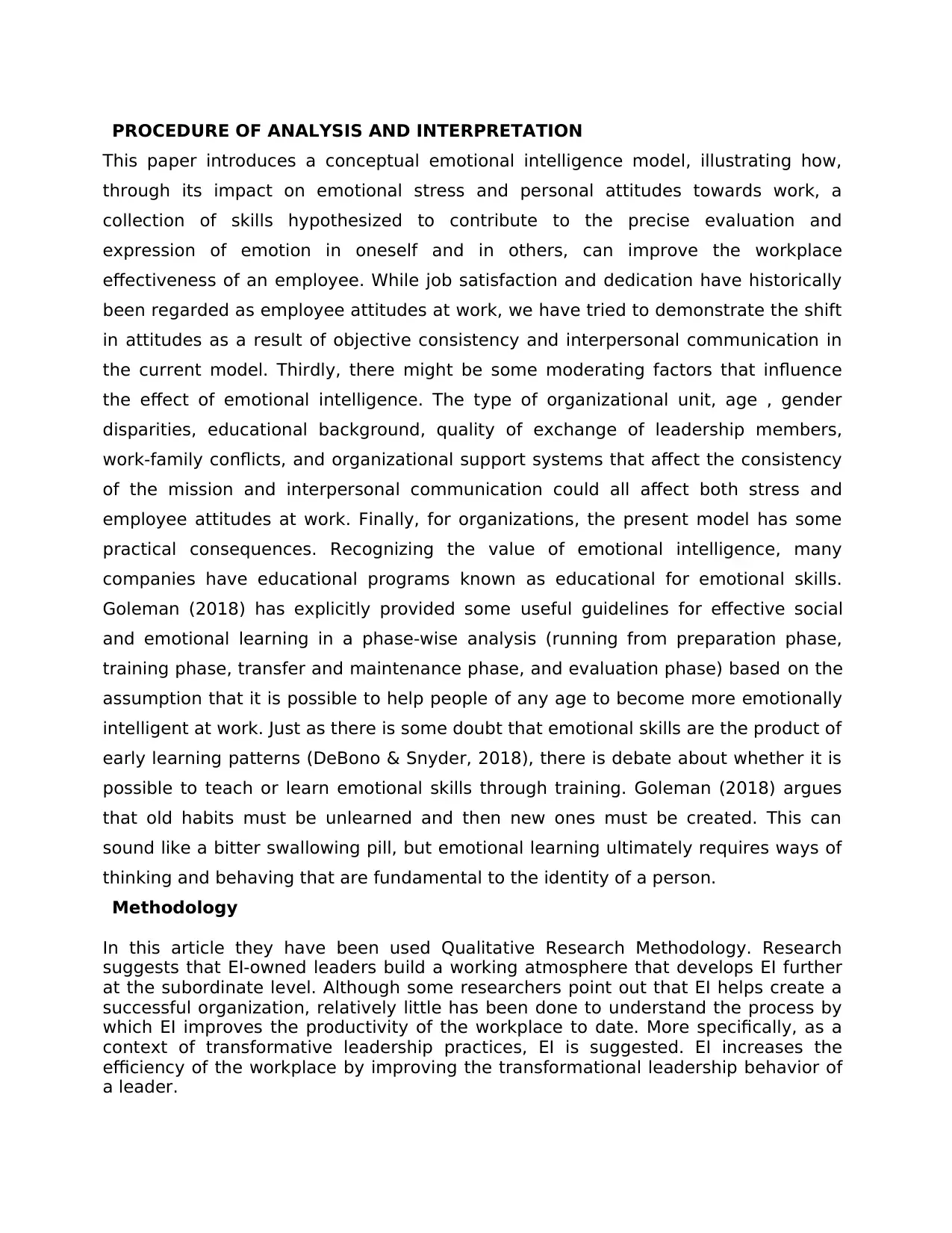
PROCEDURE OF ANALYSIS AND INTERPRETATION
This paper introduces a conceptual emotional intelligence model, illustrating how,
through its impact on emotional stress and personal attitudes towards work, a
collection of skills hypothesized to contribute to the precise evaluation and
expression of emotion in oneself and in others, can improve the workplace
effectiveness of an employee. While job satisfaction and dedication have historically
been regarded as employee attitudes at work, we have tried to demonstrate the shift
in attitudes as a result of objective consistency and interpersonal communication in
the current model. Thirdly, there might be some moderating factors that influence
the effect of emotional intelligence. The type of organizational unit, age , gender
disparities, educational background, quality of exchange of leadership members,
work-family conflicts, and organizational support systems that affect the consistency
of the mission and interpersonal communication could all affect both stress and
employee attitudes at work. Finally, for organizations, the present model has some
practical consequences. Recognizing the value of emotional intelligence, many
companies have educational programs known as educational for emotional skills.
Goleman (2018) has explicitly provided some useful guidelines for effective social
and emotional learning in a phase-wise analysis (running from preparation phase,
training phase, transfer and maintenance phase, and evaluation phase) based on the
assumption that it is possible to help people of any age to become more emotionally
intelligent at work. Just as there is some doubt that emotional skills are the product of
early learning patterns (DeBono & Snyder, 2018), there is debate about whether it is
possible to teach or learn emotional skills through training. Goleman (2018) argues
that old habits must be unlearned and then new ones must be created. This can
sound like a bitter swallowing pill, but emotional learning ultimately requires ways of
thinking and behaving that are fundamental to the identity of a person.
Methodology
In this article they have been used Qualitative Research Methodology. Research
suggests that EI-owned leaders build a working atmosphere that develops EI further
at the subordinate level. Although some researchers point out that EI helps create a
successful organization, relatively little has been done to understand the process by
which EI improves the productivity of the workplace to date. More specifically, as a
context of transformative leadership practices, EI is suggested. EI increases the
efficiency of the workplace by improving the transformational leadership behavior of
a leader.
This paper introduces a conceptual emotional intelligence model, illustrating how,
through its impact on emotional stress and personal attitudes towards work, a
collection of skills hypothesized to contribute to the precise evaluation and
expression of emotion in oneself and in others, can improve the workplace
effectiveness of an employee. While job satisfaction and dedication have historically
been regarded as employee attitudes at work, we have tried to demonstrate the shift
in attitudes as a result of objective consistency and interpersonal communication in
the current model. Thirdly, there might be some moderating factors that influence
the effect of emotional intelligence. The type of organizational unit, age , gender
disparities, educational background, quality of exchange of leadership members,
work-family conflicts, and organizational support systems that affect the consistency
of the mission and interpersonal communication could all affect both stress and
employee attitudes at work. Finally, for organizations, the present model has some
practical consequences. Recognizing the value of emotional intelligence, many
companies have educational programs known as educational for emotional skills.
Goleman (2018) has explicitly provided some useful guidelines for effective social
and emotional learning in a phase-wise analysis (running from preparation phase,
training phase, transfer and maintenance phase, and evaluation phase) based on the
assumption that it is possible to help people of any age to become more emotionally
intelligent at work. Just as there is some doubt that emotional skills are the product of
early learning patterns (DeBono & Snyder, 2018), there is debate about whether it is
possible to teach or learn emotional skills through training. Goleman (2018) argues
that old habits must be unlearned and then new ones must be created. This can
sound like a bitter swallowing pill, but emotional learning ultimately requires ways of
thinking and behaving that are fundamental to the identity of a person.
Methodology
In this article they have been used Qualitative Research Methodology. Research
suggests that EI-owned leaders build a working atmosphere that develops EI further
at the subordinate level. Although some researchers point out that EI helps create a
successful organization, relatively little has been done to understand the process by
which EI improves the productivity of the workplace to date. More specifically, as a
context of transformative leadership practices, EI is suggested. EI increases the
efficiency of the workplace by improving the transformational leadership behavior of
a leader.
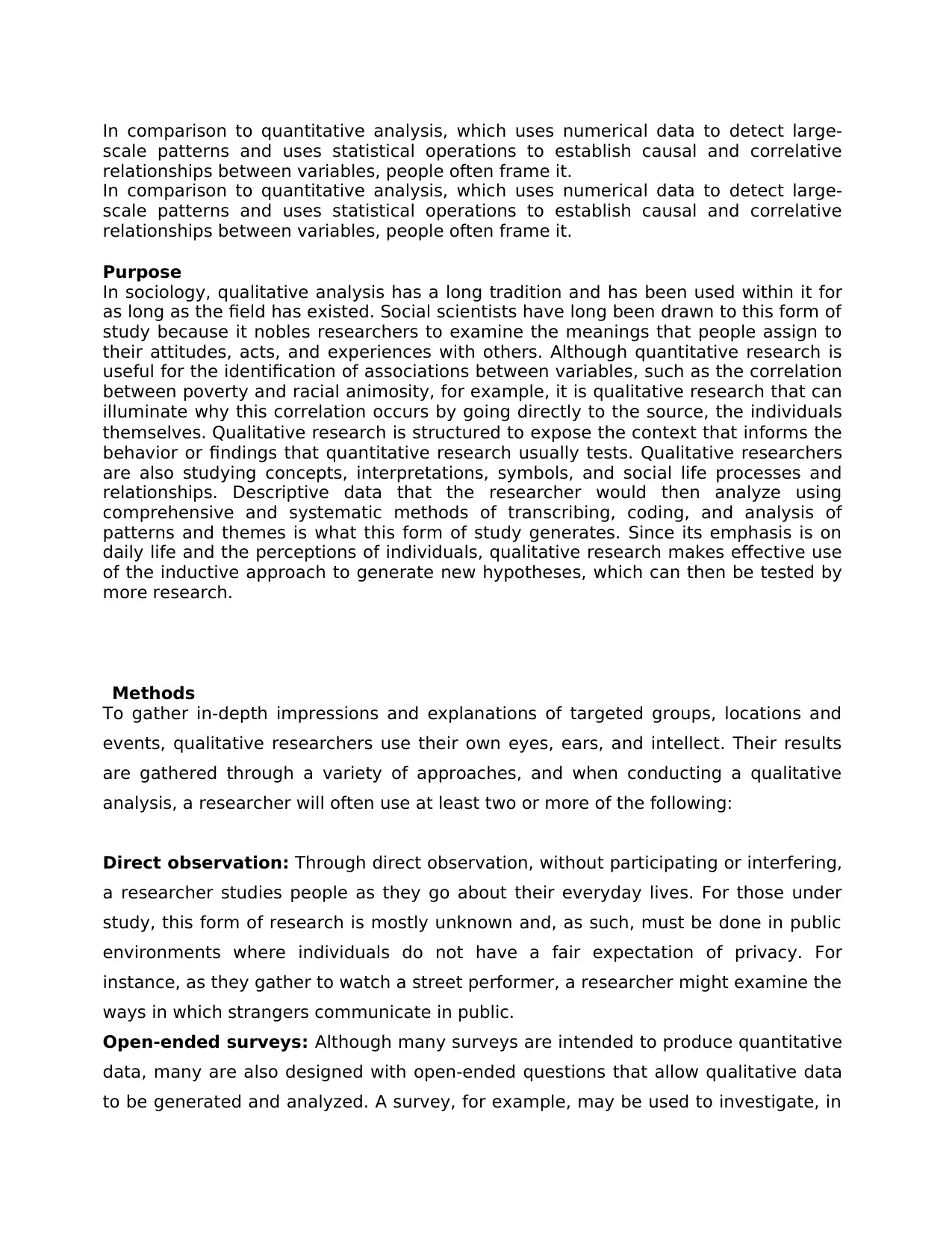
In comparison to quantitative analysis, which uses numerical data to detect large-
scale patterns and uses statistical operations to establish causal and correlative
relationships between variables, people often frame it.
In comparison to quantitative analysis, which uses numerical data to detect large-
scale patterns and uses statistical operations to establish causal and correlative
relationships between variables, people often frame it.
Purpose
In sociology, qualitative analysis has a long tradition and has been used within it for
as long as the field has existed. Social scientists have long been drawn to this form of
study because it nobles researchers to examine the meanings that people assign to
their attitudes, acts, and experiences with others. Although quantitative research is
useful for the identification of associations between variables, such as the correlation
between poverty and racial animosity, for example, it is qualitative research that can
illuminate why this correlation occurs by going directly to the source, the individuals
themselves. Qualitative research is structured to expose the context that informs the
behavior or findings that quantitative research usually tests. Qualitative researchers
are also studying concepts, interpretations, symbols, and social life processes and
relationships. Descriptive data that the researcher would then analyze using
comprehensive and systematic methods of transcribing, coding, and analysis of
patterns and themes is what this form of study generates. Since its emphasis is on
daily life and the perceptions of individuals, qualitative research makes effective use
of the inductive approach to generate new hypotheses, which can then be tested by
more research.
Methods
To gather in-depth impressions and explanations of targeted groups, locations and
events, qualitative researchers use their own eyes, ears, and intellect. Their results
are gathered through a variety of approaches, and when conducting a qualitative
analysis, a researcher will often use at least two or more of the following:
Direct observation: Through direct observation, without participating or interfering,
a researcher studies people as they go about their everyday lives. For those under
study, this form of research is mostly unknown and, as such, must be done in public
environments where individuals do not have a fair expectation of privacy. For
instance, as they gather to watch a street performer, a researcher might examine the
ways in which strangers communicate in public.
Open-ended surveys: Although many surveys are intended to produce quantitative
data, many are also designed with open-ended questions that allow qualitative data
to be generated and analyzed. A survey, for example, may be used to investigate, in
scale patterns and uses statistical operations to establish causal and correlative
relationships between variables, people often frame it.
In comparison to quantitative analysis, which uses numerical data to detect large-
scale patterns and uses statistical operations to establish causal and correlative
relationships between variables, people often frame it.
Purpose
In sociology, qualitative analysis has a long tradition and has been used within it for
as long as the field has existed. Social scientists have long been drawn to this form of
study because it nobles researchers to examine the meanings that people assign to
their attitudes, acts, and experiences with others. Although quantitative research is
useful for the identification of associations between variables, such as the correlation
between poverty and racial animosity, for example, it is qualitative research that can
illuminate why this correlation occurs by going directly to the source, the individuals
themselves. Qualitative research is structured to expose the context that informs the
behavior or findings that quantitative research usually tests. Qualitative researchers
are also studying concepts, interpretations, symbols, and social life processes and
relationships. Descriptive data that the researcher would then analyze using
comprehensive and systematic methods of transcribing, coding, and analysis of
patterns and themes is what this form of study generates. Since its emphasis is on
daily life and the perceptions of individuals, qualitative research makes effective use
of the inductive approach to generate new hypotheses, which can then be tested by
more research.
Methods
To gather in-depth impressions and explanations of targeted groups, locations and
events, qualitative researchers use their own eyes, ears, and intellect. Their results
are gathered through a variety of approaches, and when conducting a qualitative
analysis, a researcher will often use at least two or more of the following:
Direct observation: Through direct observation, without participating or interfering,
a researcher studies people as they go about their everyday lives. For those under
study, this form of research is mostly unknown and, as such, must be done in public
environments where individuals do not have a fair expectation of privacy. For
instance, as they gather to watch a street performer, a researcher might examine the
ways in which strangers communicate in public.
Open-ended surveys: Although many surveys are intended to produce quantitative
data, many are also designed with open-ended questions that allow qualitative data
to be generated and analyzed. A survey, for example, may be used to investigate, in
Secure Best Marks with AI Grader
Need help grading? Try our AI Grader for instant feedback on your assignments.
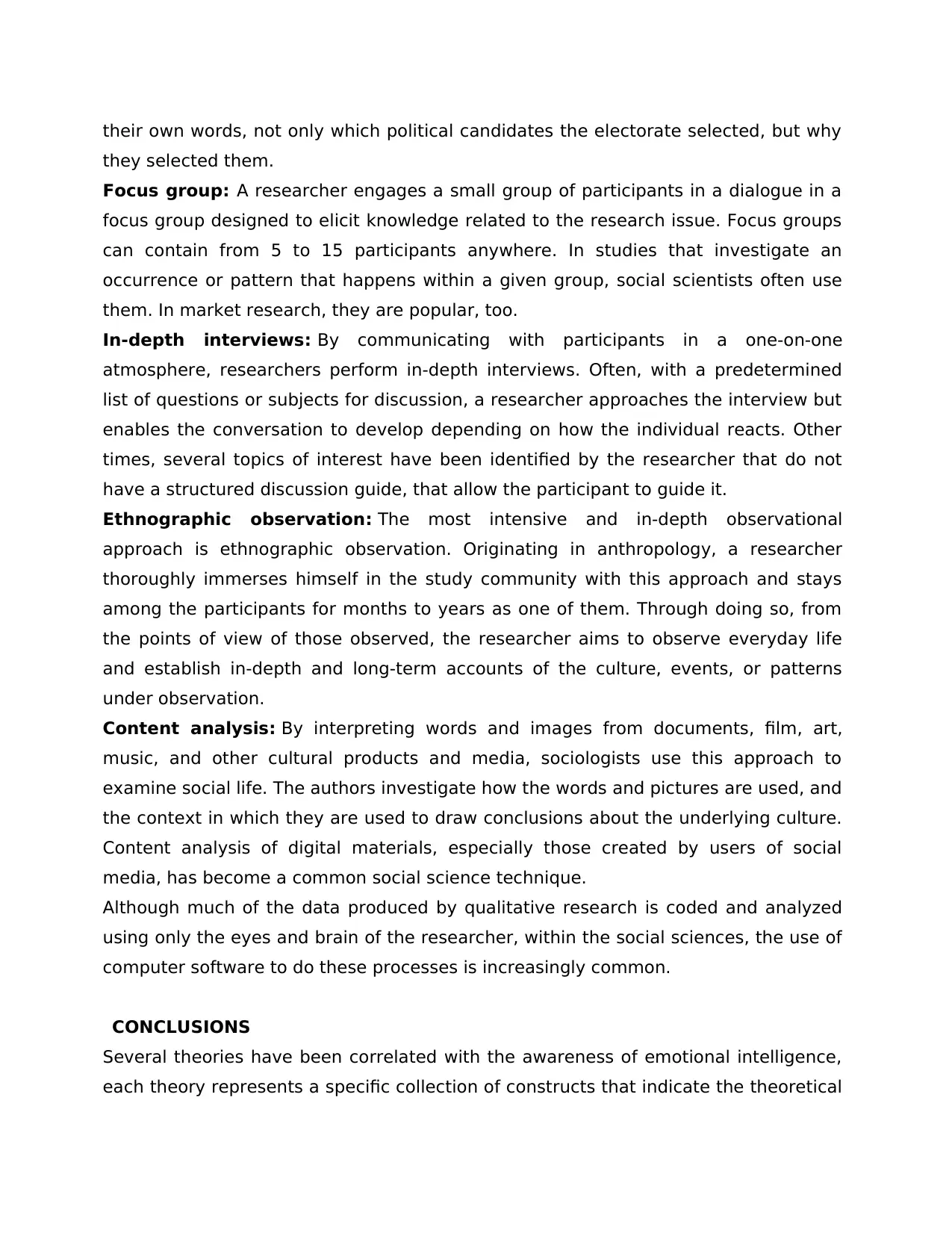
their own words, not only which political candidates the electorate selected, but why
they selected them.
Focus group: A researcher engages a small group of participants in a dialogue in a
focus group designed to elicit knowledge related to the research issue. Focus groups
can contain from 5 to 15 participants anywhere. In studies that investigate an
occurrence or pattern that happens within a given group, social scientists often use
them. In market research, they are popular, too.
In-depth interviews: By communicating with participants in a one-on-one
atmosphere, researchers perform in-depth interviews. Often, with a predetermined
list of questions or subjects for discussion, a researcher approaches the interview but
enables the conversation to develop depending on how the individual reacts. Other
times, several topics of interest have been identified by the researcher that do not
have a structured discussion guide, that allow the participant to guide it.
Ethnographic observation: The most intensive and in-depth observational
approach is ethnographic observation. Originating in anthropology, a researcher
thoroughly immerses himself in the study community with this approach and stays
among the participants for months to years as one of them. Through doing so, from
the points of view of those observed, the researcher aims to observe everyday life
and establish in-depth and long-term accounts of the culture, events, or patterns
under observation.
Content analysis: By interpreting words and images from documents, film, art,
music, and other cultural products and media, sociologists use this approach to
examine social life. The authors investigate how the words and pictures are used, and
the context in which they are used to draw conclusions about the underlying culture.
Content analysis of digital materials, especially those created by users of social
media, has become a common social science technique.
Although much of the data produced by qualitative research is coded and analyzed
using only the eyes and brain of the researcher, within the social sciences, the use of
computer software to do these processes is increasingly common.
CONCLUSIONS
Several theories have been correlated with the awareness of emotional intelligence,
each theory represents a specific collection of constructs that indicate the theoretical
they selected them.
Focus group: A researcher engages a small group of participants in a dialogue in a
focus group designed to elicit knowledge related to the research issue. Focus groups
can contain from 5 to 15 participants anywhere. In studies that investigate an
occurrence or pattern that happens within a given group, social scientists often use
them. In market research, they are popular, too.
In-depth interviews: By communicating with participants in a one-on-one
atmosphere, researchers perform in-depth interviews. Often, with a predetermined
list of questions or subjects for discussion, a researcher approaches the interview but
enables the conversation to develop depending on how the individual reacts. Other
times, several topics of interest have been identified by the researcher that do not
have a structured discussion guide, that allow the participant to guide it.
Ethnographic observation: The most intensive and in-depth observational
approach is ethnographic observation. Originating in anthropology, a researcher
thoroughly immerses himself in the study community with this approach and stays
among the participants for months to years as one of them. Through doing so, from
the points of view of those observed, the researcher aims to observe everyday life
and establish in-depth and long-term accounts of the culture, events, or patterns
under observation.
Content analysis: By interpreting words and images from documents, film, art,
music, and other cultural products and media, sociologists use this approach to
examine social life. The authors investigate how the words and pictures are used, and
the context in which they are used to draw conclusions about the underlying culture.
Content analysis of digital materials, especially those created by users of social
media, has become a common social science technique.
Although much of the data produced by qualitative research is coded and analyzed
using only the eyes and brain of the researcher, within the social sciences, the use of
computer software to do these processes is increasingly common.
CONCLUSIONS
Several theories have been correlated with the awareness of emotional intelligence,
each theory represents a specific collection of constructs that indicate the theoretical
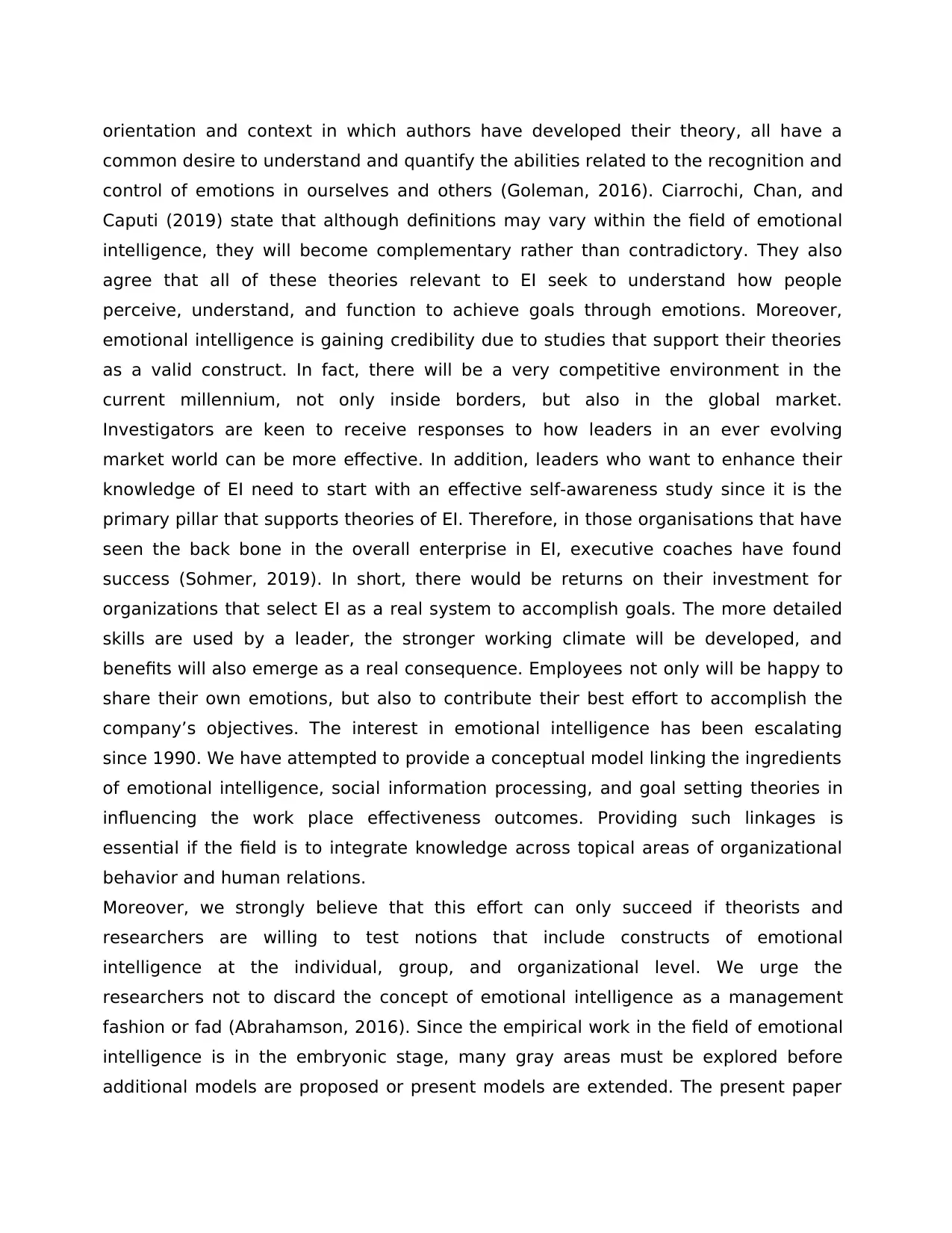
orientation and context in which authors have developed their theory, all have a
common desire to understand and quantify the abilities related to the recognition and
control of emotions in ourselves and others (Goleman, 2016). Ciarrochi, Chan, and
Caputi (2019) state that although definitions may vary within the field of emotional
intelligence, they will become complementary rather than contradictory. They also
agree that all of these theories relevant to EI seek to understand how people
perceive, understand, and function to achieve goals through emotions. Moreover,
emotional intelligence is gaining credibility due to studies that support their theories
as a valid construct. In fact, there will be a very competitive environment in the
current millennium, not only inside borders, but also in the global market.
Investigators are keen to receive responses to how leaders in an ever evolving
market world can be more effective. In addition, leaders who want to enhance their
knowledge of EI need to start with an effective self-awareness study since it is the
primary pillar that supports theories of EI. Therefore, in those organisations that have
seen the back bone in the overall enterprise in EI, executive coaches have found
success (Sohmer, 2019). In short, there would be returns on their investment for
organizations that select EI as a real system to accomplish goals. The more detailed
skills are used by a leader, the stronger working climate will be developed, and
benefits will also emerge as a real consequence. Employees not only will be happy to
share their own emotions, but also to contribute their best effort to accomplish the
company’s objectives. The interest in emotional intelligence has been escalating
since 1990. We have attempted to provide a conceptual model linking the ingredients
of emotional intelligence, social information processing, and goal setting theories in
influencing the work place effectiveness outcomes. Providing such linkages is
essential if the field is to integrate knowledge across topical areas of organizational
behavior and human relations.
Moreover, we strongly believe that this effort can only succeed if theorists and
researchers are willing to test notions that include constructs of emotional
intelligence at the individual, group, and organizational level. We urge the
researchers not to discard the concept of emotional intelligence as a management
fashion or fad (Abrahamson, 2016). Since the empirical work in the field of emotional
intelligence is in the embryonic stage, many gray areas must be explored before
additional models are proposed or present models are extended. The present paper
common desire to understand and quantify the abilities related to the recognition and
control of emotions in ourselves and others (Goleman, 2016). Ciarrochi, Chan, and
Caputi (2019) state that although definitions may vary within the field of emotional
intelligence, they will become complementary rather than contradictory. They also
agree that all of these theories relevant to EI seek to understand how people
perceive, understand, and function to achieve goals through emotions. Moreover,
emotional intelligence is gaining credibility due to studies that support their theories
as a valid construct. In fact, there will be a very competitive environment in the
current millennium, not only inside borders, but also in the global market.
Investigators are keen to receive responses to how leaders in an ever evolving
market world can be more effective. In addition, leaders who want to enhance their
knowledge of EI need to start with an effective self-awareness study since it is the
primary pillar that supports theories of EI. Therefore, in those organisations that have
seen the back bone in the overall enterprise in EI, executive coaches have found
success (Sohmer, 2019). In short, there would be returns on their investment for
organizations that select EI as a real system to accomplish goals. The more detailed
skills are used by a leader, the stronger working climate will be developed, and
benefits will also emerge as a real consequence. Employees not only will be happy to
share their own emotions, but also to contribute their best effort to accomplish the
company’s objectives. The interest in emotional intelligence has been escalating
since 1990. We have attempted to provide a conceptual model linking the ingredients
of emotional intelligence, social information processing, and goal setting theories in
influencing the work place effectiveness outcomes. Providing such linkages is
essential if the field is to integrate knowledge across topical areas of organizational
behavior and human relations.
Moreover, we strongly believe that this effort can only succeed if theorists and
researchers are willing to test notions that include constructs of emotional
intelligence at the individual, group, and organizational level. We urge the
researchers not to discard the concept of emotional intelligence as a management
fashion or fad (Abrahamson, 2016). Since the empirical work in the field of emotional
intelligence is in the embryonic stage, many gray areas must be explored before
additional models are proposed or present models are extended. The present paper
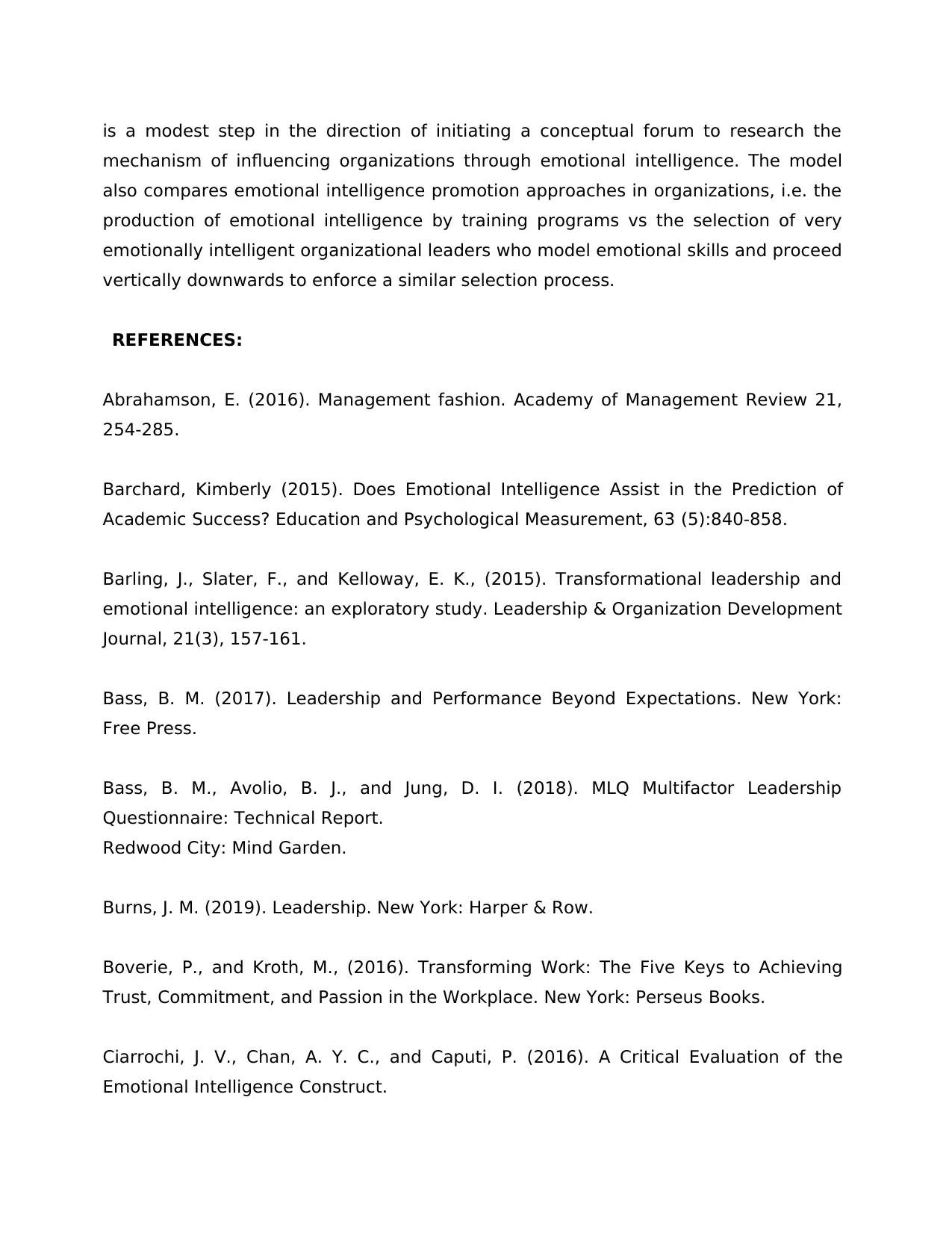
is a modest step in the direction of initiating a conceptual forum to research the
mechanism of influencing organizations through emotional intelligence. The model
also compares emotional intelligence promotion approaches in organizations, i.e. the
production of emotional intelligence by training programs vs the selection of very
emotionally intelligent organizational leaders who model emotional skills and proceed
vertically downwards to enforce a similar selection process.
REFERENCES:
Abrahamson, E. (2016). Management fashion. Academy of Management Review 21,
254-285.
Barchard, Kimberly (2015). Does Emotional Intelligence Assist in the Prediction of
Academic Success? Education and Psychological Measurement, 63 (5):840-858.
Barling, J., Slater, F., and Kelloway, E. K., (2015). Transformational leadership and
emotional intelligence: an exploratory study. Leadership & Organization Development
Journal, 21(3), 157-161.
Bass, B. M. (2017). Leadership and Performance Beyond Expectations. New York:
Free Press.
Bass, B. M., Avolio, B. J., and Jung, D. I. (2018). MLQ Multifactor Leadership
Questionnaire: Technical Report.
Redwood City: Mind Garden.
Burns, J. M. (2019). Leadership. New York: Harper & Row.
Boverie, P., and Kroth, M., (2016). Transforming Work: The Five Keys to Achieving
Trust, Commitment, and Passion in the Workplace. New York: Perseus Books.
Ciarrochi, J. V., Chan, A. Y. C., and Caputi, P. (2016). A Critical Evaluation of the
Emotional Intelligence Construct.
mechanism of influencing organizations through emotional intelligence. The model
also compares emotional intelligence promotion approaches in organizations, i.e. the
production of emotional intelligence by training programs vs the selection of very
emotionally intelligent organizational leaders who model emotional skills and proceed
vertically downwards to enforce a similar selection process.
REFERENCES:
Abrahamson, E. (2016). Management fashion. Academy of Management Review 21,
254-285.
Barchard, Kimberly (2015). Does Emotional Intelligence Assist in the Prediction of
Academic Success? Education and Psychological Measurement, 63 (5):840-858.
Barling, J., Slater, F., and Kelloway, E. K., (2015). Transformational leadership and
emotional intelligence: an exploratory study. Leadership & Organization Development
Journal, 21(3), 157-161.
Bass, B. M. (2017). Leadership and Performance Beyond Expectations. New York:
Free Press.
Bass, B. M., Avolio, B. J., and Jung, D. I. (2018). MLQ Multifactor Leadership
Questionnaire: Technical Report.
Redwood City: Mind Garden.
Burns, J. M. (2019). Leadership. New York: Harper & Row.
Boverie, P., and Kroth, M., (2016). Transforming Work: The Five Keys to Achieving
Trust, Commitment, and Passion in the Workplace. New York: Perseus Books.
Ciarrochi, J. V., Chan, A. Y. C., and Caputi, P. (2016). A Critical Evaluation of the
Emotional Intelligence Construct.
Paraphrase This Document
Need a fresh take? Get an instant paraphrase of this document with our AI Paraphraser
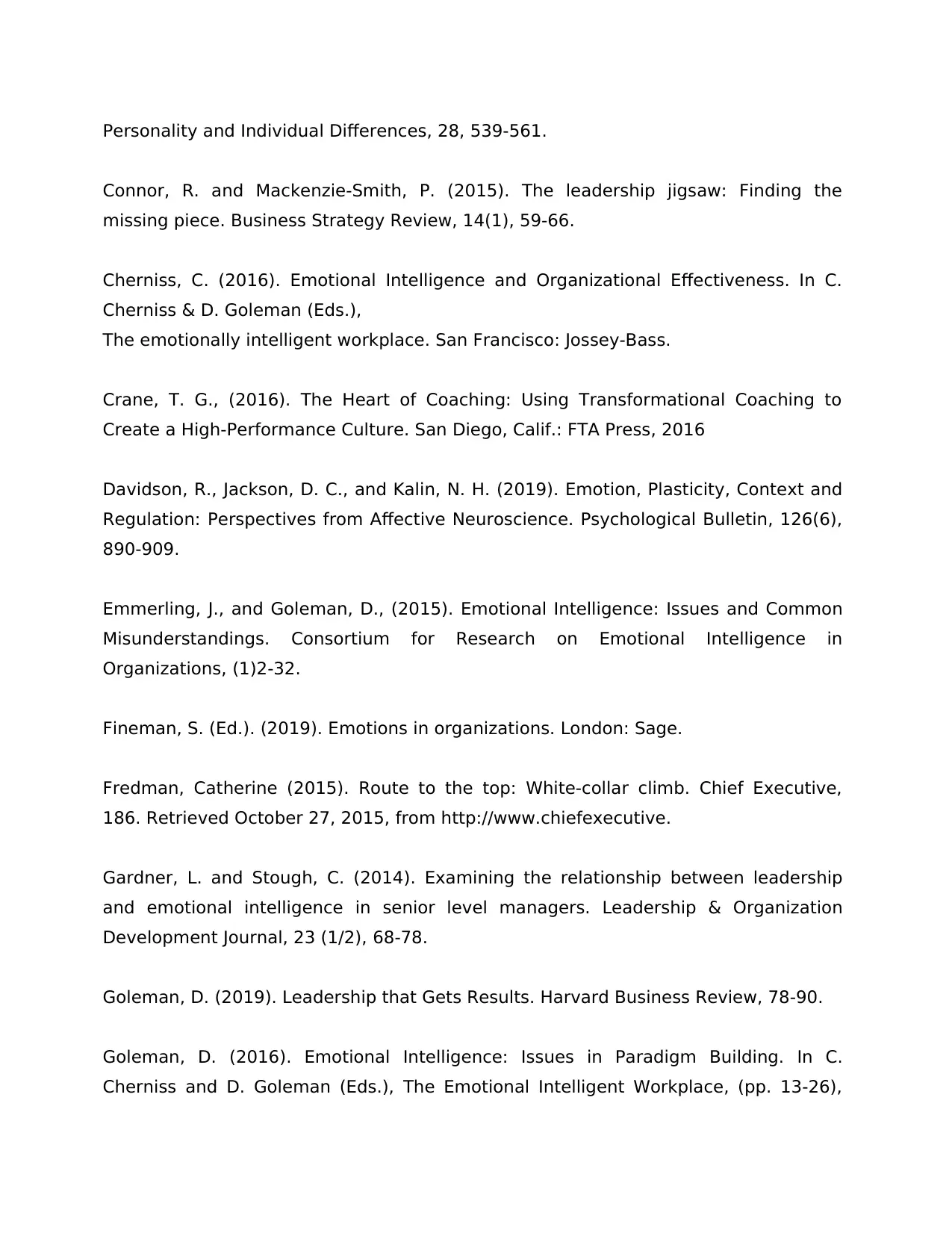
Personality and Individual Differences, 28, 539-561.
Connor, R. and Mackenzie-Smith, P. (2015). The leadership jigsaw: Finding the
missing piece. Business Strategy Review, 14(1), 59-66.
Cherniss, C. (2016). Emotional Intelligence and Organizational Effectiveness. In C.
Cherniss & D. Goleman (Eds.),
The emotionally intelligent workplace. San Francisco: Jossey-Bass.
Crane, T. G., (2016). The Heart of Coaching: Using Transformational Coaching to
Create a High-Performance Culture. San Diego, Calif.: FTA Press, 2016
Davidson, R., Jackson, D. C., and Kalin, N. H. (2019). Emotion, Plasticity, Context and
Regulation: Perspectives from Affective Neuroscience. Psychological Bulletin, 126(6),
890-909.
Emmerling, J., and Goleman, D., (2015). Emotional Intelligence: Issues and Common
Misunderstandings. Consortium for Research on Emotional Intelligence in
Organizations, (1)2-32.
Fineman, S. (Ed.). (2019). Emotions in organizations. London: Sage.
Fredman, Catherine (2015). Route to the top: White-collar climb. Chief Executive,
186. Retrieved October 27, 2015, from http://www.chiefexecutive.
Gardner, L. and Stough, C. (2014). Examining the relationship between leadership
and emotional intelligence in senior level managers. Leadership & Organization
Development Journal, 23 (1/2), 68-78.
Goleman, D. (2019). Leadership that Gets Results. Harvard Business Review, 78-90.
Goleman, D. (2016). Emotional Intelligence: Issues in Paradigm Building. In C.
Cherniss and D. Goleman (Eds.), The Emotional Intelligent Workplace, (pp. 13-26),
Connor, R. and Mackenzie-Smith, P. (2015). The leadership jigsaw: Finding the
missing piece. Business Strategy Review, 14(1), 59-66.
Cherniss, C. (2016). Emotional Intelligence and Organizational Effectiveness. In C.
Cherniss & D. Goleman (Eds.),
The emotionally intelligent workplace. San Francisco: Jossey-Bass.
Crane, T. G., (2016). The Heart of Coaching: Using Transformational Coaching to
Create a High-Performance Culture. San Diego, Calif.: FTA Press, 2016
Davidson, R., Jackson, D. C., and Kalin, N. H. (2019). Emotion, Plasticity, Context and
Regulation: Perspectives from Affective Neuroscience. Psychological Bulletin, 126(6),
890-909.
Emmerling, J., and Goleman, D., (2015). Emotional Intelligence: Issues and Common
Misunderstandings. Consortium for Research on Emotional Intelligence in
Organizations, (1)2-32.
Fineman, S. (Ed.). (2019). Emotions in organizations. London: Sage.
Fredman, Catherine (2015). Route to the top: White-collar climb. Chief Executive,
186. Retrieved October 27, 2015, from http://www.chiefexecutive.
Gardner, L. and Stough, C. (2014). Examining the relationship between leadership
and emotional intelligence in senior level managers. Leadership & Organization
Development Journal, 23 (1/2), 68-78.
Goleman, D. (2019). Leadership that Gets Results. Harvard Business Review, 78-90.
Goleman, D. (2016). Emotional Intelligence: Issues in Paradigm Building. In C.
Cherniss and D. Goleman (Eds.), The Emotional Intelligent Workplace, (pp. 13-26),
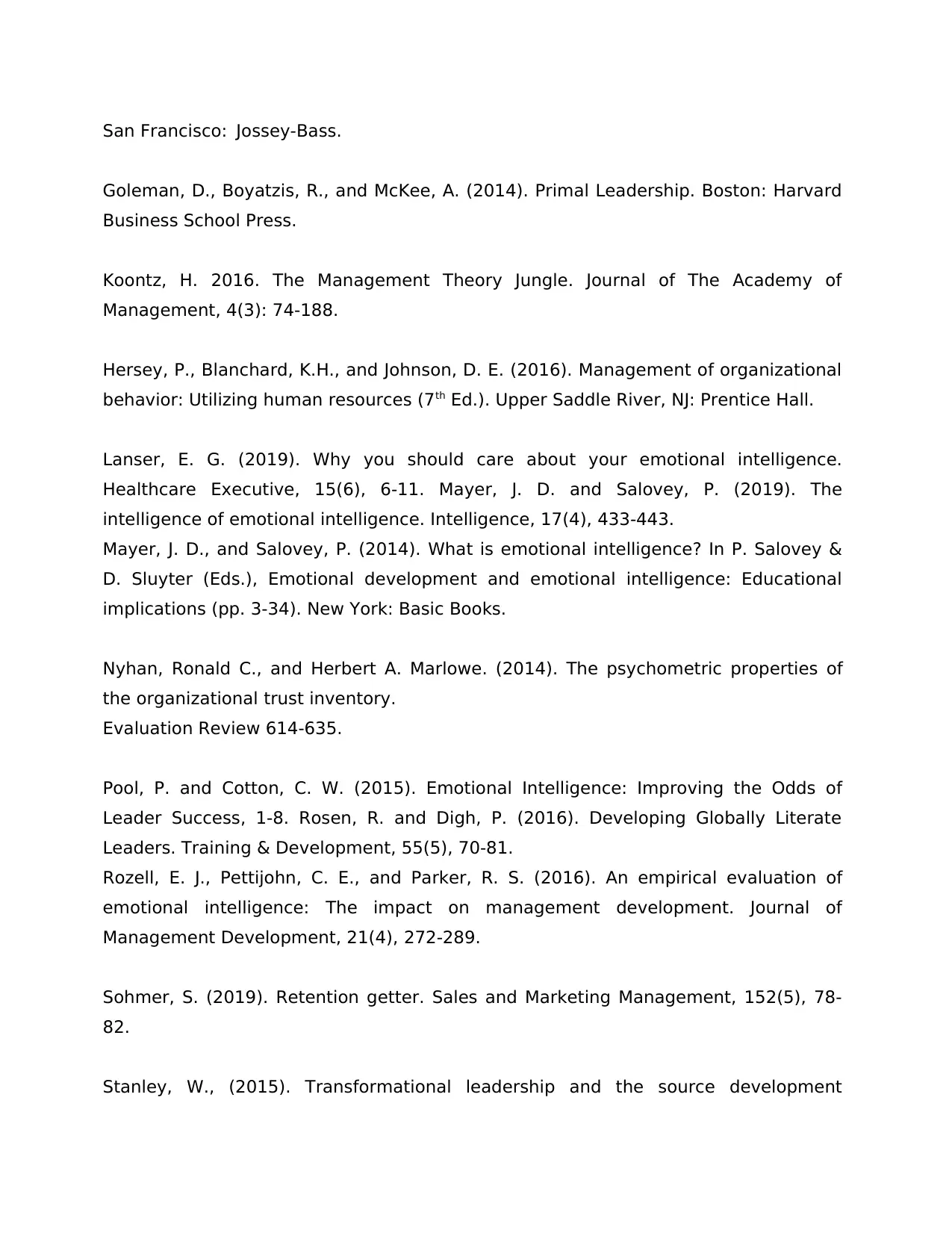
San Francisco: Jossey-Bass.
Goleman, D., Boyatzis, R., and McKee, A. (2014). Primal Leadership. Boston: Harvard
Business School Press.
Koontz, H. 2016. The Management Theory Jungle. Journal of The Academy of
Management, 4(3): 74-188.
Hersey, P., Blanchard, K.H., and Johnson, D. E. (2016). Management of organizational
behavior: Utilizing human resources (7th Ed.). Upper Saddle River, NJ: Prentice Hall.
Lanser, E. G. (2019). Why you should care about your emotional intelligence.
Healthcare Executive, 15(6), 6-11. Mayer, J. D. and Salovey, P. (2019). The
intelligence of emotional intelligence. Intelligence, 17(4), 433-443.
Mayer, J. D., and Salovey, P. (2014). What is emotional intelligence? In P. Salovey &
D. Sluyter (Eds.), Emotional development and emotional intelligence: Educational
implications (pp. 3-34). New York: Basic Books.
Nyhan, Ronald C., and Herbert A. Marlowe. (2014). The psychometric properties of
the organizational trust inventory.
Evaluation Review 614-635.
Pool, P. and Cotton, C. W. (2015). Emotional Intelligence: Improving the Odds of
Leader Success, 1-8. Rosen, R. and Digh, P. (2016). Developing Globally Literate
Leaders. Training & Development, 55(5), 70-81.
Rozell, E. J., Pettijohn, C. E., and Parker, R. S. (2016). An empirical evaluation of
emotional intelligence: The impact on management development. Journal of
Management Development, 21(4), 272-289.
Sohmer, S. (2019). Retention getter. Sales and Marketing Management, 152(5), 78-
82.
Stanley, W., (2015). Transformational leadership and the source development
Goleman, D., Boyatzis, R., and McKee, A. (2014). Primal Leadership. Boston: Harvard
Business School Press.
Koontz, H. 2016. The Management Theory Jungle. Journal of The Academy of
Management, 4(3): 74-188.
Hersey, P., Blanchard, K.H., and Johnson, D. E. (2016). Management of organizational
behavior: Utilizing human resources (7th Ed.). Upper Saddle River, NJ: Prentice Hall.
Lanser, E. G. (2019). Why you should care about your emotional intelligence.
Healthcare Executive, 15(6), 6-11. Mayer, J. D. and Salovey, P. (2019). The
intelligence of emotional intelligence. Intelligence, 17(4), 433-443.
Mayer, J. D., and Salovey, P. (2014). What is emotional intelligence? In P. Salovey &
D. Sluyter (Eds.), Emotional development and emotional intelligence: Educational
implications (pp. 3-34). New York: Basic Books.
Nyhan, Ronald C., and Herbert A. Marlowe. (2014). The psychometric properties of
the organizational trust inventory.
Evaluation Review 614-635.
Pool, P. and Cotton, C. W. (2015). Emotional Intelligence: Improving the Odds of
Leader Success, 1-8. Rosen, R. and Digh, P. (2016). Developing Globally Literate
Leaders. Training & Development, 55(5), 70-81.
Rozell, E. J., Pettijohn, C. E., and Parker, R. S. (2016). An empirical evaluation of
emotional intelligence: The impact on management development. Journal of
Management Development, 21(4), 272-289.
Sohmer, S. (2019). Retention getter. Sales and Marketing Management, 152(5), 78-
82.
Stanley, W., (2015). Transformational leadership and the source development
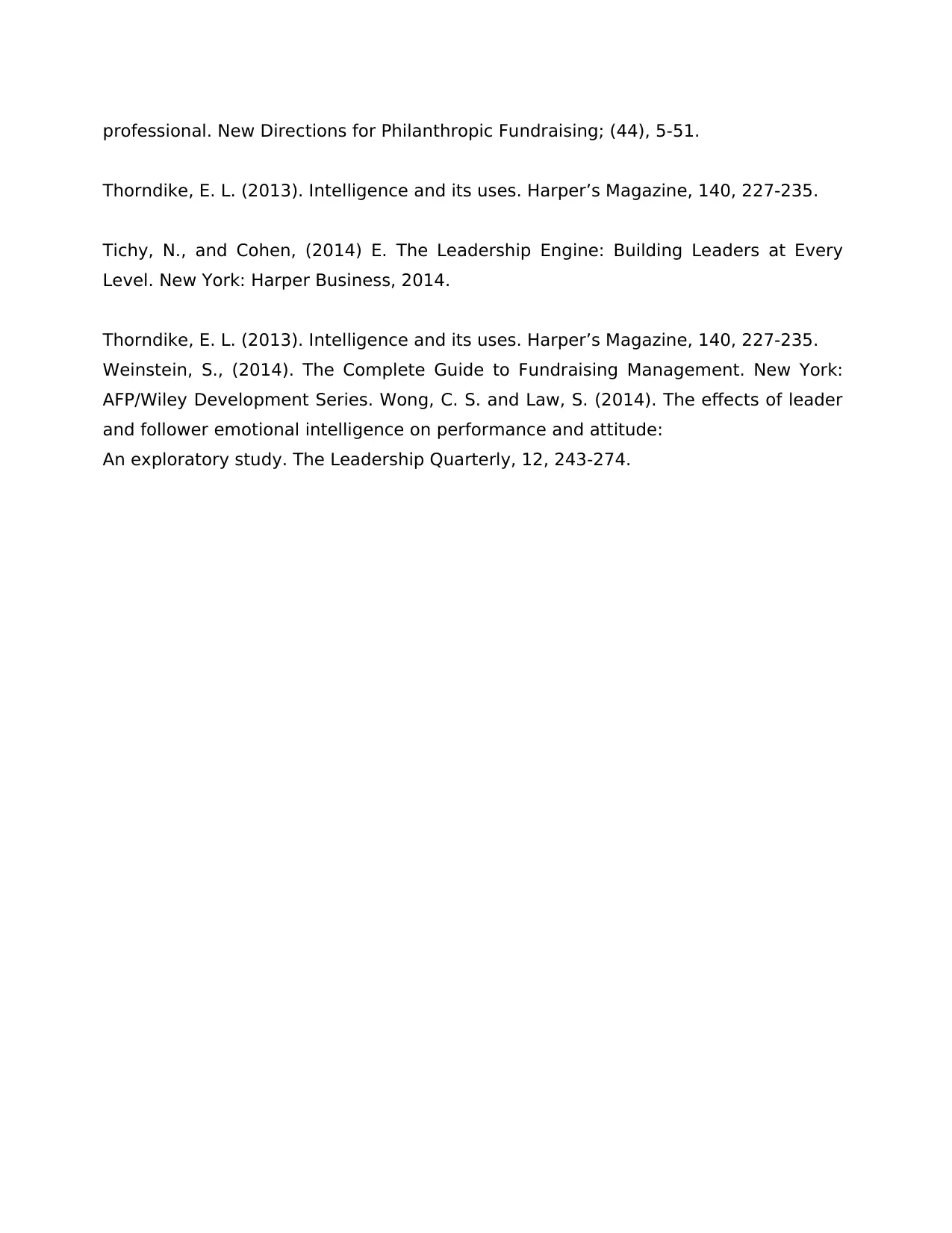
professional. New Directions for Philanthropic Fundraising; (44), 5-51.
Thorndike, E. L. (2013). Intelligence and its uses. Harper’s Magazine, 140, 227-235.
Tichy, N., and Cohen, (2014) E. The Leadership Engine: Building Leaders at Every
Level. New York: Harper Business, 2014.
Thorndike, E. L. (2013). Intelligence and its uses. Harper’s Magazine, 140, 227-235.
Weinstein, S., (2014). The Complete Guide to Fundraising Management. New York:
AFP/Wiley Development Series. Wong, C. S. and Law, S. (2014). The effects of leader
and follower emotional intelligence on performance and attitude:
An exploratory study. The Leadership Quarterly, 12, 243-274.
Thorndike, E. L. (2013). Intelligence and its uses. Harper’s Magazine, 140, 227-235.
Tichy, N., and Cohen, (2014) E. The Leadership Engine: Building Leaders at Every
Level. New York: Harper Business, 2014.
Thorndike, E. L. (2013). Intelligence and its uses. Harper’s Magazine, 140, 227-235.
Weinstein, S., (2014). The Complete Guide to Fundraising Management. New York:
AFP/Wiley Development Series. Wong, C. S. and Law, S. (2014). The effects of leader
and follower emotional intelligence on performance and attitude:
An exploratory study. The Leadership Quarterly, 12, 243-274.
1 out of 22
Your All-in-One AI-Powered Toolkit for Academic Success.
+13062052269
info@desklib.com
Available 24*7 on WhatsApp / Email
![[object Object]](/_next/static/media/star-bottom.7253800d.svg)
Unlock your academic potential
© 2024 | Zucol Services PVT LTD | All rights reserved.

